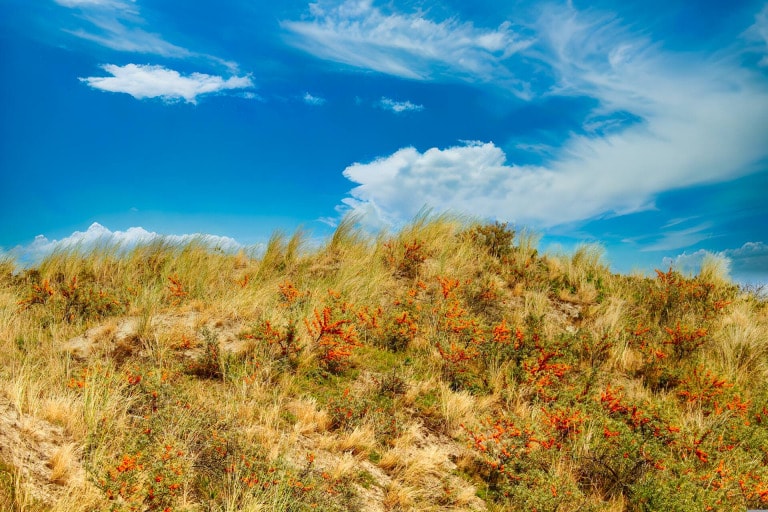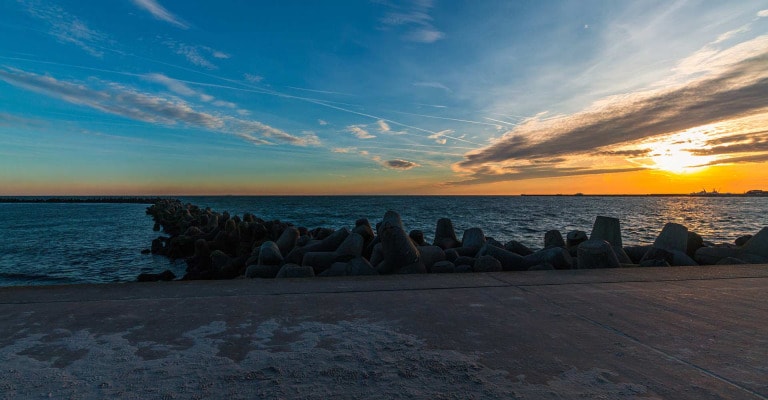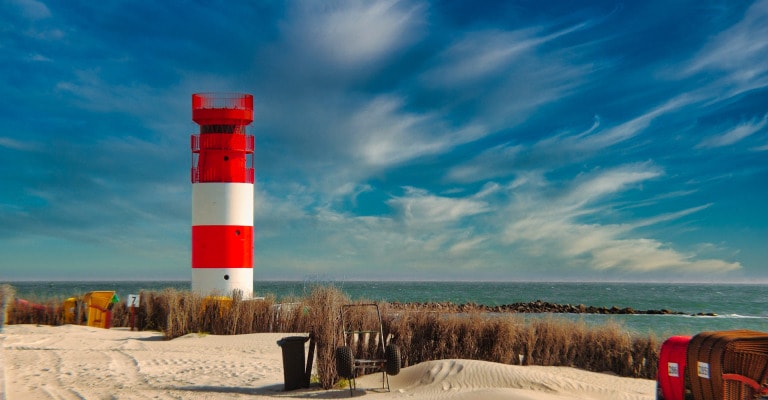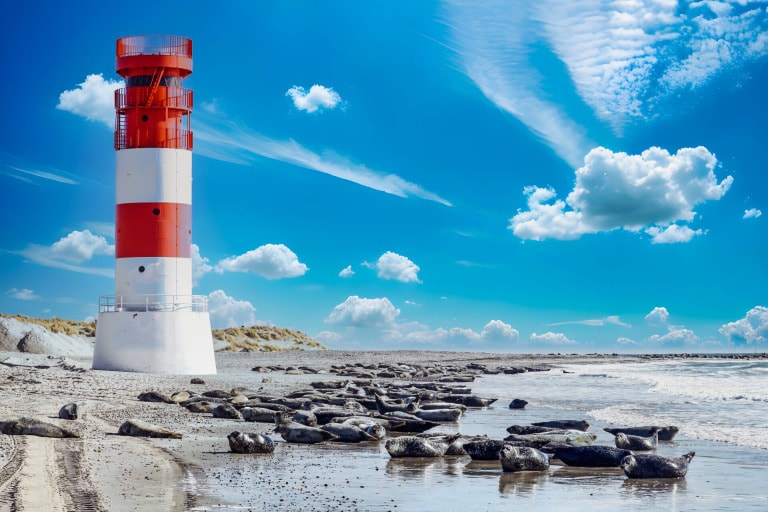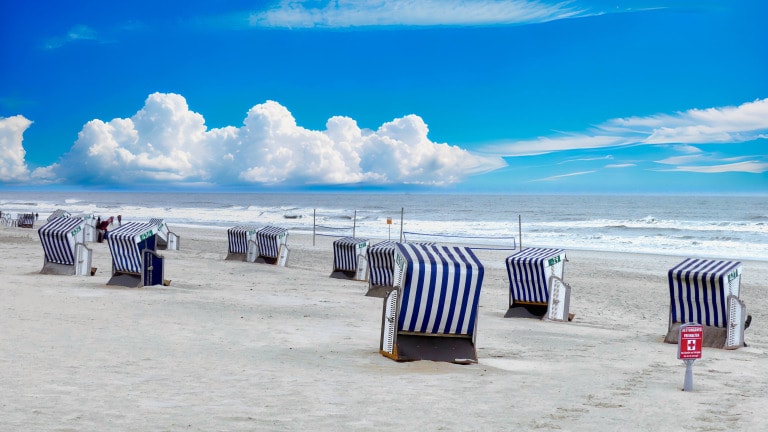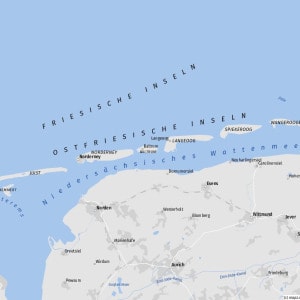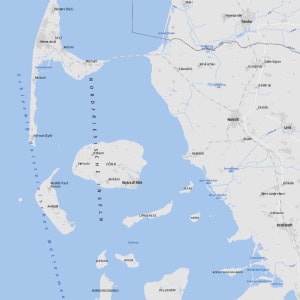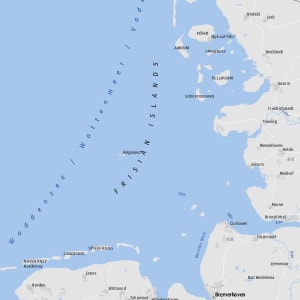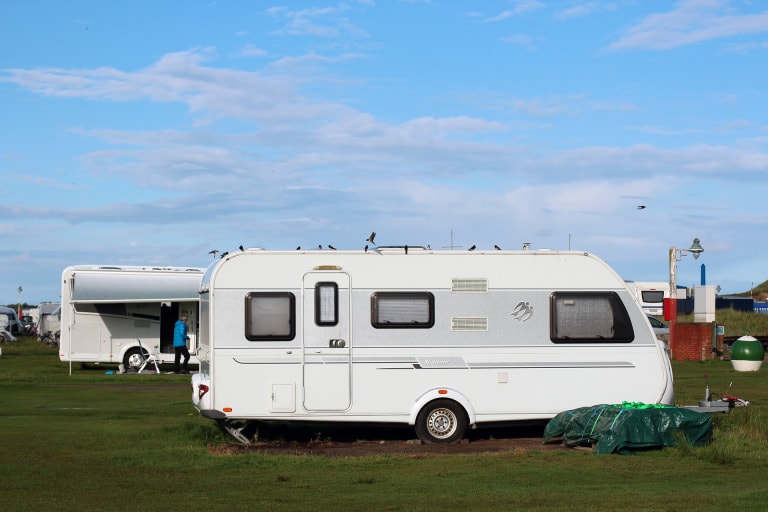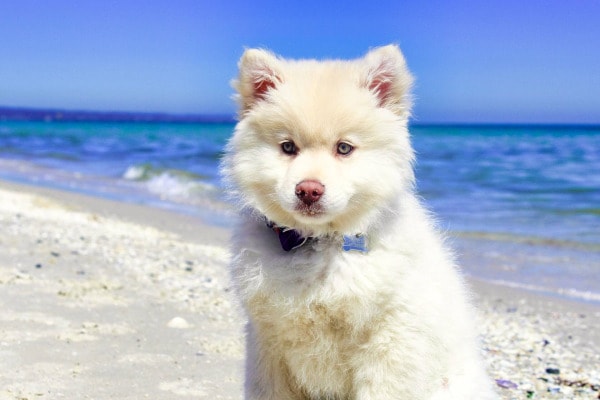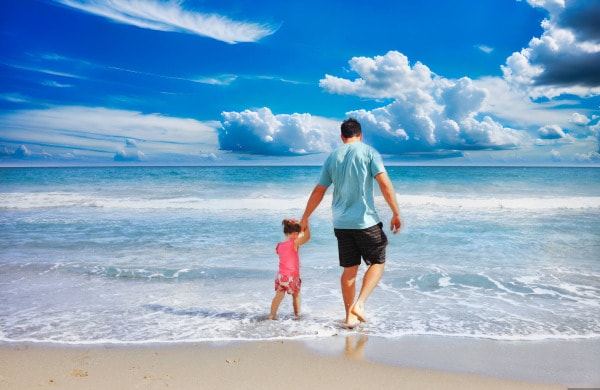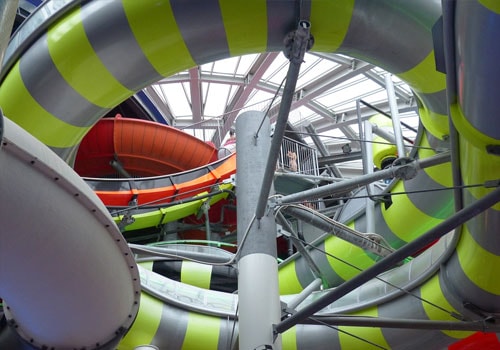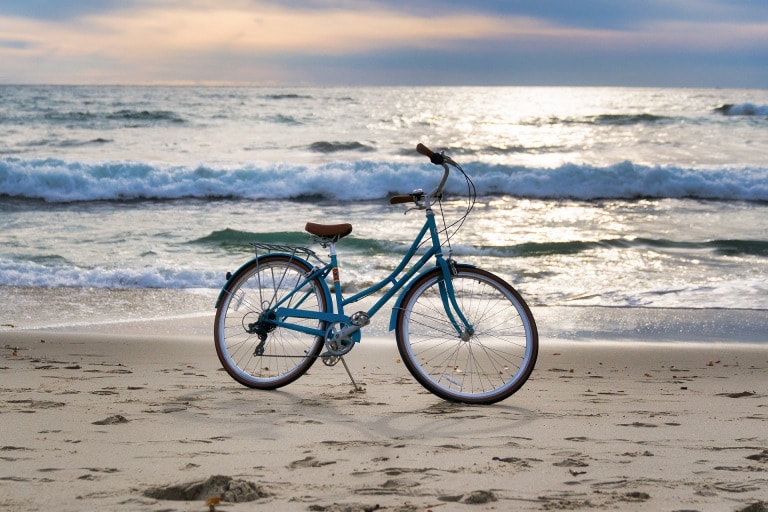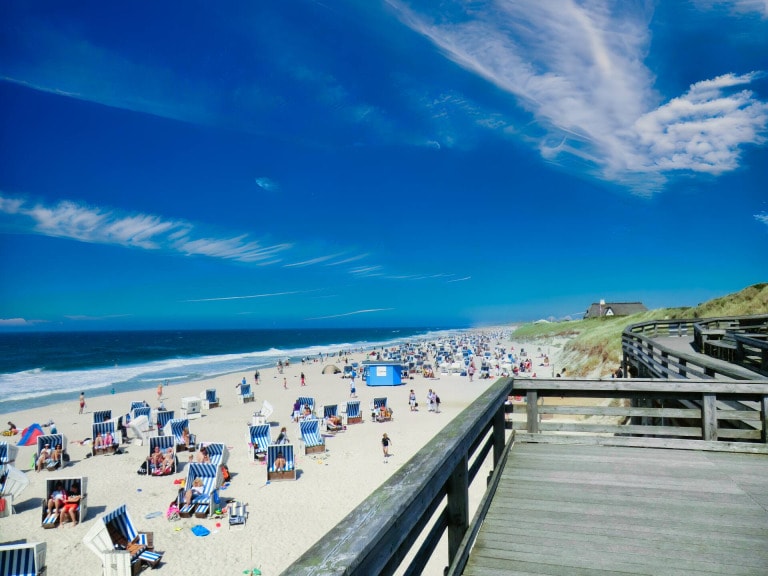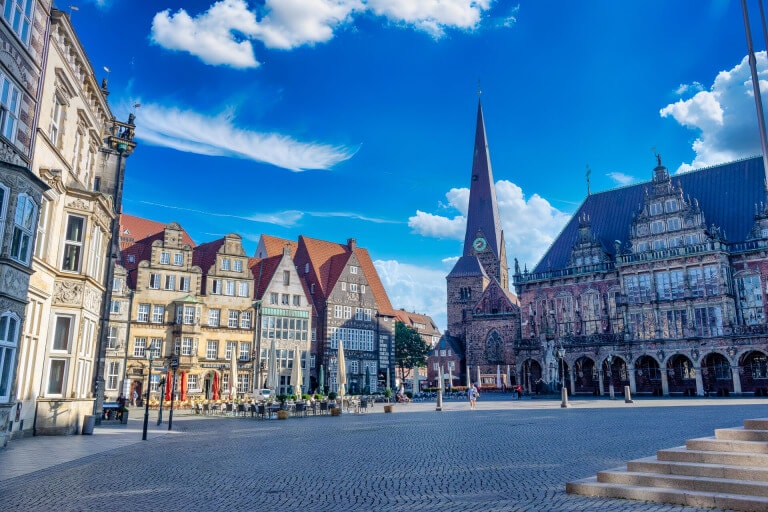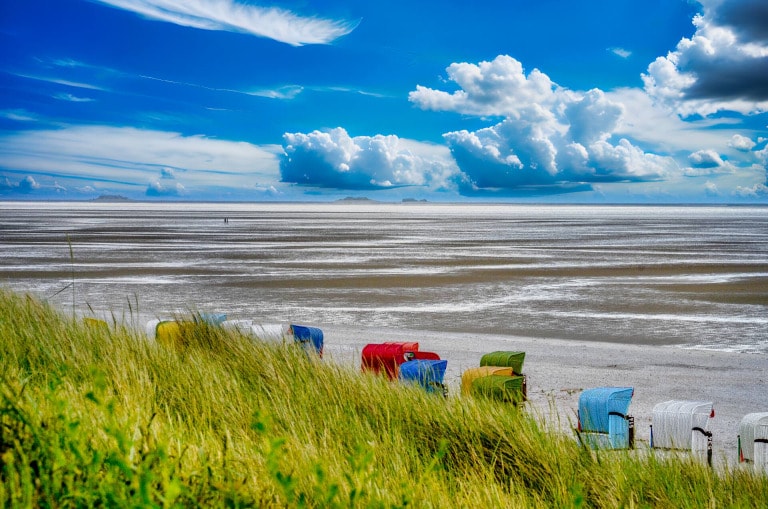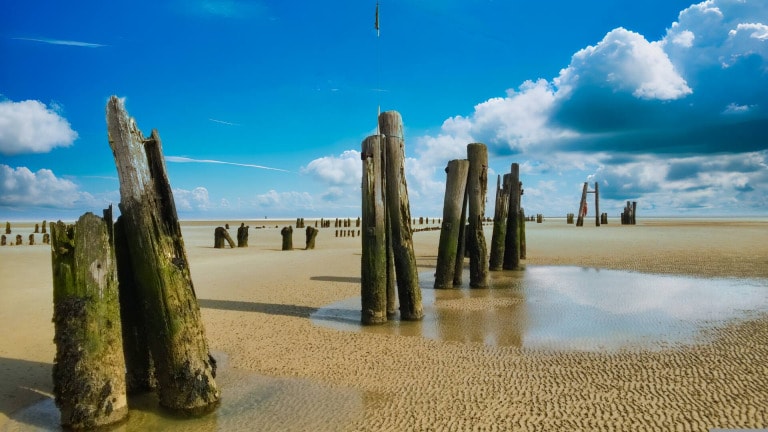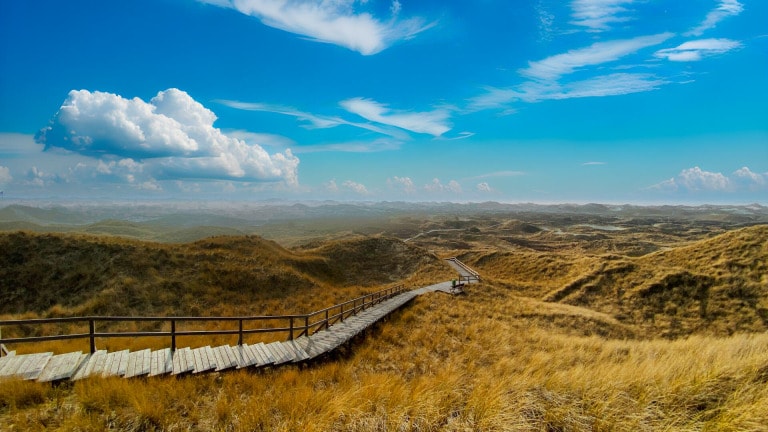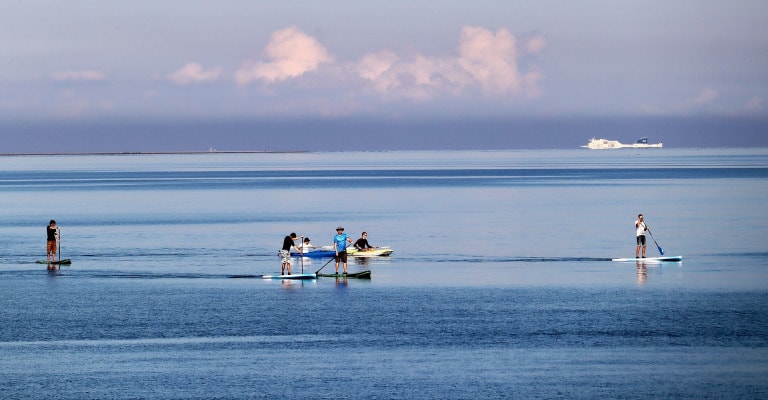North Sea island Sylt - the North Frisian island on the North Sea
If you are looking for a picturesque, lively and fun vacation destination, the
North Sea island Sylt just the thing for you! The island in front of the
German coast is famous for its breathtaking views, miles of pristine beaches and exciting nightlife.
Even getting to Sylt is an adventure. You can take the train from Hamburg to Sylt, which takes about 5 hours, or you can fly to Sylt Airport, which is served by many airlines from different cities in Germany.
Once you arrive on the island, the first thing you will notice is the breathtaking landscape. The island is a nature lover's paradise with miles of sandy beaches, picturesque dunes and rolling hills. The island is best explored by bike or by car, which can be rented from many car rental companies.
One of the island's main attractions is the Wadden Sea, which has been declared a UNESCO World Heritage Site. This stunning natural wonder offers the opportunity to discover the unique flora and fauna while enjoying the fresh sea air. During a boat trip you can watch seals or observe migratory birds in their natural habitat in the bird sanctuary.
Besides the beauty of nature, Sylt is also known for its vibrant nightlife. The town of Westerland is the main attraction for visitors and here you will find numerous bars, clubs and restaurants that have something to offer for every taste. From live music to DJ sets, there is always something happening on Sylt.
When it comes to accommodation, Sylt also has something to offer for everyone. From cozy guesthouses to luxurious hotels, there is something for every budget and taste. Most hotels and guesthouses are located near the beach, so you can enjoy the sun, sand and sea during your stay.
North Sea island Amrum - Wide dune landscape
Ah,
Amrum . The
North Sea island is a hidden gem waiting to be discovered. Those looking for a charming vacation destination with fine sandy beaches, picturesque villages and a relaxed atmosphere will feel right at home on this island.
The journey to Amrum begins with a ferry ride from the mainland. The ferry port is located in Dagebüll. There you can park your car or take the train from Hamburg to nearby Niebüll. Even the ferry ride is an experience and offers a breathtaking view of the North German coast.
Once on the island, you'll be greeted by an idyllic landscape with miles of windswept beaches, pristine dunes and striking lighthouses. Whether you are a nature lover, interested in history or simply looking for relaxation - there is a lot to see and experience on Amrum.
One of the most popular sights on the island is the historic lighthouse in Norddorf. Built in 1875, the lighthouse rises 41 meters into the air and offers a panoramic view of the North Sea and the island. A staircase leads to the top of the lighthouse, where you can enjoy the expansive view and learn about the history of the lighthouse.
Another worthwhile destination on Amrum is the village of Wittdün. Here you can explore the charming alleys with half-timbered houses and try fresh fish dishes in one of the restaurants. The town also has a beautiful beach where you can swim, sunbathe or relax with a good book.
If you want to make your vacation more active, you can go biking or hiking on the many trails of the island or try windsurfing or kitesurfing on the beaches. You can also take a whale watching tour to see seals, porpoises and other sea creatures in their natural habitat.
Amrum offers suitable accommodation for every taste and budget. You can rent a cozy vacation home or apartment in one of the charming villages of the island or stay in a hotel or guesthouse overlooking the North Sea.
North Sea island Föhr - the North Frisian island in the Wadden Sea National Park
The North Frisian island of Föhr is the perfect destination for those seeking relaxation, adventure and breathtaking sights. From the moment you arrive, you will be enchanted by the island's charm, relaxed atmosphere and friendly locals. Whether alone, with family or friends, Föhr has something to offer for everyone.
Thanks to regular ferry connections from the mainland, getting to this magical island is a breeze. Those who arrive on Föhr by ferry are greeted by a sense of tranquility that immediately makes you forget the stress of modern life. The island is easy to reach by car, bike or on foot and is therefore suitable for both a day trip and a longer vacation.
Once you arrive, you can take the time to explore the island's many attractions. From the historic town center of Wyk to the stunning beaches of the Wadden Sea, there is much to see and experience. You can stroll through the charming villages of Nieblum, Oevenum or Wrixum and admire the beautiful old Frisian farmhouses. The cultural history of the island is also fascinating and can be explored in the Frisian Museum in Wyk or the Uthlande Museum in Wyk.
One of the main attractions of the North Sea island is the Wadden Sea National Park. The UNESCO World Heritage Site is a paradise for nature lovers and offers breathtaking views of the Wadden Sea, the salt marshes and sand dunes that make up this unique landscape. The Wadden Sea is home to an incredible variety of birds and marine life, and visitors can join guided tours or explore the area on their own.
A North Sea
Vacation on Föhr is an unforgettable experience, because there are a variety of activities that will keep you entertained during your stay. You can spend your days cycling, horseback riding, sailing or kite surfing. If you like it a bit quieter, you will find plenty of opportunities to recharge your batteries in the spas, wellness centers and on the sandy beaches of the island.
Föhr is also known for its regional cuisine with many traditional dishes made from seafood, potatoes or fresh vegetables. The island's restaurants and cafes offer a wide range of delicious dishes, from hearty meals to light snacks and refreshing drinks.
North Sea Island Pellworm
Those who are looking for a unique vacation destination are on
Pellworm , one of the North Frisian
North Sea Islands , just right. With a breathtaking natural landscape, a rich history and a lively atmosphere is
Pellworm the perfect place for a relaxing and exciting vacation at the North Sea.
Even the journey to Pellworm is an experience. You can travel by ferry from Husum or Schlüttsiel or even by plane from Hamburg. Once there, the island welcomes you with open arms. Rustic houses and friendly locals welcome you and show you around the island.
There are many sights on Pellworm, from the traditional windmills to the old lighthouse. You can explore the island on foot or by bike and enjoy the breathtaking views of the Wadden Sea. If you are adventurous, you can even join a guided mudflat hike and explore the unique ecosystem of the Wadden Sea.
But it's not all about sightseeing. It's also a great place for a relaxing vacation on the North Sea. There are plenty of beaches to soak up the sun, and the island's wellness centers offer a variety of treatments to help you unwind. And if you are hungry, you can enjoy the delicious local cuisine with fresh fish and seafood.
One of the highlights is the Wadden Sea itself. This unique ecosystem is a UNESCO World Heritage Site and is full of wildlife. You can watch birds or even see seals on one of the many mudflat walks.
Nordstrand - the peninsula in the Wadden Sea
Those who want to escape the hustle and bustle of everyday life are on
North Beach just right. The picturesque North Frisian island is an oasis of natural beauty and typical coastal charm, just waiting to be discovered.
Already the journey to
North Beach is an experience. As you approach the island, the sky opens up and the endless blue of the Wadden Sea welcomes you. The UNESCO World Heritage Site stretches along the coasts of Germany, the Netherlands and Denmark. The island can be reached by car, but you can also take a ferry from the mainland, which is a wonderful way to see the landscape up close.
Once on the island, there is much to see and experience. North Beach has a rich history and offers a number of attractions that reflect its past as a bustling trading center. Visitors can tour the island's historic 17th-century lighthouse or stroll through the picturesque village of Odenbüll, with its traditional thatched-roof houses and cozy cafes.
But perhaps the most beautiful thing about Nordstrand is the opportunity to simply relax and enjoy the natural beauty of the island. The Wadden Sea offers countless opportunities for outdoor recreation, from beach walks and bird watching to biking and hiking. One can also take part in a guided mudflat walk, where one can learn more about the unique ecosystem of this fragile landscape and the incredible wildlife that call it home.
North Sea island Helgoland: An island paradise in the North Sea
Those who travel by ferry from
Heligoland comes and enters the port of
Heligoland is greeted by a pleasant sea breeze and the breathtaking blue-green of the North Sea. The North German island, located 70 kilometers off the coast of Schleswig-Holstein, is a true jewel in disguise.
From its breathtaking natural beauty to its rich cultural heritage, Helgoland offers a wealth of sights and experiences you won't find anywhere else. Whether for a day trip or a longer vacation, this island paradise is guaranteed to leave a lasting impression.
One of Helgoland's highlights is the rugged cliffs with Lange Anna surrounding the island, offering some of the most dramatic coastal scenery in Europe, as well as the seal colony. A hike along the cliff path offers breathtaking views of the sea.
Another attraction is Lange Anna, which rises 47 meters above the waves. In the past it served as a navigational aid for passing ships, but today it is a popular place for bird watching and admiring the natural beauty of the island.
There is also much to discover on Helgoland for those interested in history. Due to its proximity to the coast, the island used to be a strategic naval base; remains of fortifications and bunkers can still be seen today.
Helgoland is the perfect destination for a North Sea vacation that combines relaxation and adventure. The beach on the neighboring island of Düne invites you to swim, sunbathe and enjoy water sports, while picturesque hiking trails and paths invite you to explore the rugged island landscape.
Those traveling with children should definitely visit the aquarium, which houses a variety of sea creatures such as seals, starfish and crabs. And adults can purchase luxury items such as perfume, tobacco and alcohol at reasonable prices in the island's famous duty-free stores.
North Sea island Wangerooge: Wadden Sea and kilometer long beach
If you are looking for the perfect vacation by the sea, you will find it on the East Frisian
Wangerooge island just right! As soon as you arrive, you will feel the fresh sea air and the relaxed island atmosphere. Whether alone, with family or with friends,
Wangerooge offers a wealth of attractions and activities that make a North Sea vacation more than just a beach trip.
The island has a rich history that is reflected in the charming red brick houses that line the streets. As soon as you step off the Wangerooge ferry that takes you to the island, you'll be greeted with stunning views of the beach, dunes, and North Sea. Take a deep breath and let the salty air fill your lungs - you've arrived in paradise!
One of the most important sights on Wangerooge is the lighthouse, which has been standing upright since 1872. You can climb its 133 steps to the top and enjoy the breathtaking panoramic view of the island and the sea. Another must-see is the Maritime Museum, which shows the maritime history and culture of the island.
The UNESCO World Heritage Wadden Sea is one of the main attractions of Wangerooge. You can take part in a guided mudflat walk and learn more about the unique ecosystem and the wildlife that lives there. The Wadden Sea is also excellent for bird watching, where you can spot rare species such as the spoonbill or the redshank.
Of course, no vacation is complete without a visit to the beach, and this beach is one of the best in the region. With a length of over 7 km, it offers plenty of space to relax, swim and play. There are also several beach bars and restaurants where you can have a drink or a meal.
If you are looking for an adventure, the North Sea island has a lot to offer. You can go cycling, windsurfing, kitesurfing or kayaking. There is also a tennis court, a golf course and a swimming pool. And if you dare, you can even try indoor skydiving!
North Sea island Spiekeroog: the idyllic island Spiekeroog - a word that includes everything that a perfect vacation resort has to offer. The beautiful and idyllic
East Frisian island in the North Sea is an ideal place for those who want to spend an eventful summer vacation.
Already upon arrival at the
North Sea island Spiekeroog you are greeted by a breathtaking view of the UNESCO World Heritage Wadden Sea. The island has a small harbor and can only be reached by Spiekeroog ferry or small plane.
Once there, there are plenty of sights and activities to keep you busy. The island is car-free, which means you can explore the surroundings on foot, by bike or a horse-drawn carriage. The main attraction of the island is the long sandy beach, which invites you to sunbathe, swim and surf in the summer.
Those interested in the history of the island should visit the Spiekeroog Museum, which shows the rich culture and tradition of the island. And for nature lovers, the island offers numerous opportunities for bird watching, hiking and exploring the Wadden Sea.
But what really sets the island apart from other vacation destinations is its relaxed and laid-back atmosphere. It's the perfect place to switch off, relax and recharge your batteries. Whether you're looking for a romantic getaway or a family vacation, the island has something for everyone.
During your stay on the island, you can choose from a variety of accommodations, from cozy guesthouses to luxurious hotels. And when it comes to food, Spiekeroog offers a wealth of culinary delights, from fresh seafood to traditional East Frisian dishes.
North Sea island Langeoog: A hidden gem on the East Frisian Islands Langeoog is a sensational island in the East Frisian Sea that you should have on your bucket list. The magical island is located in the middle of the Wadden Sea National Park and offers its visitors a unique vacation experience. From stunning sandy beaches to picturesque landscapes, it has
Langeoog everything to offer.
Already the arrival is an experience. You can reach the island by Langeoog ferry or by small plane. The ferry ride is relaxing and a good opportunity to enjoy the scenic beauty of the North Sea. Once on Langeoog, you can not escape the charm of the island.
The island is car-free, so visitors can walk at their own pace and breathe in the fresh sea air. The island's main attractions include the lighthouse, the Langeoog Museum and the beach promenade. The lighthouse, which has been in operation since 1853, is a must-see for any visitor. You can climb it and enjoy the panoramic view of the surrounding landscape. In the Langeoog Museum you can learn a lot about the unique history of the island and its inhabitants. The beach promenade invites you to take a leisurely stroll and soak up the charming island atmosphere.
A
Vacation on Langeoog is a unique experience. The relaxed atmosphere and natural beauty of the island invite you to unwind and recharge your batteries. Whether you want to swim, surf or just laze on the beach, everyone will find something to their liking here. But also outdoor activities such as hiking, cycling and horseback riding do not let boredom arise.
No visit to Langeoog is complete without a trip to the Wadden Sea National Park. The Wadden Sea is a UNESCO World Heritage Site and one of the largest tidal areas in the world. Visitors can take part in guided mudflat walks to learn more about this unique ecosystem and observe different bird species. A truly magical experience.
North Sea island Baltrum: A North Sea vacation in the Wadden Sea National Park
Looking for an unforgettable vacation destination in the north of Germany? Then you are on
Baltrum , one of the seven East Frisian islands in the UNESCO World Heritage Wadden Sea, is just right.
The journey to
Baltrum is quite simple: take the ferry from the mainland town of Neßmersiel and enjoy a 40-minute ride through the breathtaking Wadden Sea, where you can watch countless birds and seals. Look out for the island's landmark, the lighthouse, which has been guiding ships safely for more than a century.
When you arrive, you can look forward to a relaxed and charming island experience. With only 500 permanent residents, the island has a relaxed and laid-back atmosphere that is perfect for vacationers looking to get away from it all.
One of Baltrum's main attractions is its beach. It stretches for six kilometers on the eastern side of the island and is ideal for sunbathing, swimming and long walks along the coast. The water can be a bit chilly, but the magnificent view of the North Sea is well worth it.
Another place to visit is the charming island village, with its cozy cafes, restaurants serving fresh seafood, and pretty stores selling everything from handmade pottery to traditional Frisian clothing. Stroll through the village's narrow streets and admire the colorful houses and flower-filled gardens.
For nature lovers
Baltrum a paradise. The island is part of the Wadden Sea National Park, a unique ecosystem with thousands of animal and plant species. During a guided mudflat walk you can discover crabs, worms and other creatures that are at home in this unique environment.
And of course, a visit to Baltrum should not be without the famous Baltrum marzipan. The sweet delicacy made of almonds, sugar and a touch of rose water is a popular local delicacy.
North Sea island of Norderney: recreation and summer vacation or the East Frisian island
The small East Frisian island offers an unforgettable blend of natural beauty and restful serenity and is the ideal destination for those who want to relax and enjoy the beauty of nature. Whether early morning walks on the beach or bike rides through the green meadows,
Norderney has something to offer for everyone.
Already the journey to
Norderney is a unique experience, because the charming island can only be reached by the
Norderney -You can reach the island by ferry or by plane. The ferry is a popular and exciting way to get to this enchanting island, with the sparkling sea around you and a salty breeze in the air. When you get off the ferry, the first thing you notice is the lively atmosphere of the island. You have the possibility to rent bicycles or horses and explore the varied landscape of Norderney.
Norderney is a visual challenge where you can capture many sights with your camera. The island is home to a unique breed of sheep that roam over green fields and dunes, creating a picturesque image for photography enthusiasts. The Kurhaus, Norderney's landmark, is another sight to see with its impressive architecture and breathtaking views over the island. The lighthouse is also unique and the view from above is simply spectacular.
Norderney offers a fantastic variety of activities and countless ways to enjoy the island - from cycling through the dunes to swimming in the North Sea. Especially popular with tourists are mudflat walks, where you can experience the Wadden Sea up close and enjoy its beauty. The Wadden Sea is a unique ecosystem and a hike through mud and sand can be an exciting and unforgettable experience.
A North Sea vacation here is all about relaxation, and the island's laid-back atmosphere is perfect for unwinding and relieving stress. Whether you're lounging on the beach with your favorite book or enjoying the delicious local cuisine, vacationing is perfect for letting go and relaxing.
North Sea island of Juist: sun, mudflats and lots of relaxation
Also the East Frisian
Juist island is an option for summer vacation. The first thing you notice is that there are no cars on the island, which adds to the feeling of peace and relaxation. Instead, you can hear the soft clatter of horses pulling the carriages that take visitors around the island.
Juist has a lot to offer, from stunning beaches to quaint stores. One of the highlights of any visit to Juist is a walk along the Wadden Sea, which has been declared a UNESCO World Heritage Site and is home to a variety of animal and plant species.
But it's not just the sights that make Juist a perfect vacation destination. The island also has a thriving cultural scene with music and theater performances, art exhibitions and other events taking place throughout the year.
To enjoy a
Vacation on Juist to enjoy, you have to get involved with the laid-back life on the island. Relax on the beach, take a leisurely stroll through the town, or just sit and watch the world go by. Whatever you do, you'll definitely feel refreshed and rejuvenated.
North Sea Island Borkum: The summer vacation in the Wadden Sea
Planning your next vacation and looking for a destination with pristine beaches, stunning scenery and a lively atmosphere? Then the East Frisian
North Sea island Borkum just the thing for you!
As soon as you arrive on the island, you know you have something special to look forward to. The excitement starts as soon as you catch the ferry from the mainland to
Borkum climb. The closer you get to the island, the greater the anticipation and the more you feel the excitement that awaits you.
Once there, a variety of sights and activities await you that will make your vacation unforgettable. Borkum is known for its stunning coastline with long, white sandy beaches that invite you to sunbathe or take a refreshing dip in the sea. In addition to the beaches, the island also offers a variety of activities such as cycling, hiking and horseback riding, to name a few. The landscape of the island is a mixture of dunes, forests and moors and is perfect for hiking and biking.
A special feature is its location in the Wadden Sea National Park. This beautiful UNESCO World Heritage Site can be explored on guided tours, trudging through the mudflats and experiencing the rhythm of the tides.
For an active vacation, there are numerous sports facilities such as tennis courts, golf courses and a climbing park. The island is also ideal for water sports such as kite surfing, sailing and windsurfing. But that's not all! The island has a rich cultural offer with numerous events throughout the year. From concerts to theater performances, there is something for everyone. You can also visit the many museums and galleries that showcase local art and history.
Borkum offers accommodations for every budget, whether you are looking for a cozy bed & breakfast or a luxurious hotel. In the numerous restaurants and beach bars of the island you can fortify yourself with fresh and delicious food after an eventful day.
North Sea vacation rentals booking by the sea - the pros and cons
You are planning a long-awaited vacation at the German North Sea? Then you might ask yourself: Should I stay in a vacation apartment? But don't worry! Here you will find a list of pros and cons to help you decide.
Advantages: Freedom and flexibility
The best thing about a vacation rental is the freedom and flexibility it gives you. You can come and go as you please, cook your own meals and enjoy the space and privacy you wouldn't have in a hotel room. Plus, you can choose an apartment that suits your needs and preferences - from a cozy studio to a spacious family suite.
Cons: Limited service
With all the freedom, of course, comes the responsibility to take care of yourself. Unlike hotels, vacation apartments don't have 24-hour room service or daily housekeeping. You have to cook, clean and wash yourself, which is not necessarily everyone's idea of a relaxing vacation.
Pro: Cost effective
Renting a vacation home can be cheaper than staying in a hotel. For example, if you are traveling with a group or family, you can share the rent and save on meals by cooking for yourself. Also, some apartments offer discounts for longer stays, which is a great way to stay on budget.
Cons: Location and equipment
Another factor you should consider is the location and facilities of the apartment. Some apartments are further away from the beach or the city center, which is not ideal if you are looking for a central location. Also, you may not have access to facilities such as a swimming pool or a fitness center, which can be a disadvantage for some travelers.
Vacation homes on the North Sea: advantages and disadvantages
Vacation homes on the North Sea offer a unique opportunity to experience the beauty and tranquility of the North Sea while enjoying the comforts of home.
There are different types of vacation homes, from small apartments to luxurious villas. Many of these houses are located near the beach and offer easy access to the sea and breathtaking views of the coast.
One of the biggest advantages of vacation homes is their flexibility. Unlike hotels, in a vacation home you can determine your own daily routine and live independently. You can prepare your own meals in a fully equipped kitchen, use a private outdoor area and relax in a spacious living room.
Another advantage is the price. For large families or groups of friends, renting a vacation home can be much cheaper than staying in a hotel. You can share the rental costs and save money on meals by cooking at home.
However, there are some disadvantages as well. For example, you have to keep the house clean and tidy throughout your stay. This is more stressful than in a hotel room, where housekeeping takes care of everything.
Also, vacation homes can be lonelier than hotels. If you're looking for a lively atmosphere and lots of social interaction, a hotel may be a better choice. However, if you prefer a quiet and peaceful environment, a vacation home may be the perfect choice.
When you book a vacation home for your North Sea vacation, you'll typically have access to a number of amenities, including a fully equipped kitchen, a large living room, and an outdoor area for dining and relaxing. Many vacation homes also have access to a communal pool or playground, making them ideal for families with children.
Camping on the North Sea - the pros and cons. Pro: The great outdoors
Camping is above all a return to nature, and the
North Sea coast is the perfect playground for outdoor enthusiasts. There are miles of coastline with breathtaking views, sandy beaches and endless opportunities for fishing, swimming and boating. You can also hike through the dunes, explore hidden coves and estuaries, and observe wildlife.
Contra: The weather
The North Sea coast and the North Sea islands are known for their unpredictable weather. Even in summer, the weather can be unpredictable, as sunny spells are often followed by strong winds, rain showers and even thunderstorms. So you should be prepared for all weather conditions and pack accordingly.
Pro: Cheap vacation
One of the biggest advantages of camping on the German North Sea is that it's a cheap vacation option. A pitch at a campsite can be had for just a few euros a night, and if you cook for yourself and bring your own supplies, you can save money.
Cons: Overcrowded campsites
At the height of summer, many campgrounds can be crowded and you may have to share a space with other campers. You may also have to queue for showers and toilets and there may be noise from neighboring campsites. However, this can easily be avoided by choosing a quieter site or camping out of season.
Pro: Fun for the whole family
Camping is a great way to spend time with the family. Children can play outside, make new friends and learn about nature. Many campsites also offer activities such as archery, horseback riding and water sports.
Cons: Limited comfort
Camping is not always the most comfortable solution. You may have to sleep on the ground, deal with insects and get used to using communal toilets and showers. But this can be easily avoided by choosing accommodation with more comfort or bringing your own camping equipment.
Despite the drawbacks, camping on the North Sea islands can be a beautiful and unforgettable experience. The miles of stunning coastline, beautiful nature and affordable prices are a great way to get away from it all and rediscover nature. So, pitch your tent, pack up your family or friends and let's go!
North Sea vacation with motorhome - mobility for sightseeing
Before you pack up your motorhome and head out, you should be aware of the pros and cons of a motorhome vacation on the German North Sea.
Pro: Freedom and flexibility
One of the greatest advantages of a motorhome vacation is the freedom and flexibility it offers. You can go where you want, stop when you want, and stay as long as you want. Whether you want to explore the coast, visit historic towns, or just relax on the beach, an RV vacation gives you the freedom to do everything at your own pace.
Disadvantage: Limited space
The downside is that it can be quite cramped in a motorhome, especially if you are traveling with more than two people. You have to carry light luggage and be prepared to share a small living and sleeping area. But with a little planning and organization, you can make the most of the limited space and enjoy a comfortable and cozy vacation.
Pro: Beautiful landscapes and breathtaking views
One of the best aspects is the opportunity to explore the countryside from the car and enjoy breathtaking views. Along the German North Sea coast there are miles of beautiful coastline, rolling hills and charming villages that are perfect for exploring by motorhome.
Disadvantage: Driving and navigation problems
Driving can be a challenge, especially if you're not used to dealing with such a large and unwieldy vehicle. You have to deal with narrow roads, steep hills, sharp turns and face the challenges of parking in campgrounds. But with practice and patience, you can master the art and enjoy all the benefits this type of vacation has to offer.
Pro: Affordable accommodation
Compared to traditional hotels and resorts, camping can be very affordable, especially if you're willing to risk a little more. You can save money on accommodation, food and entertainment and still enjoy the comforts of home.
Disadvantage: Maintenance and assembly
Unfortunately, RVs require some maintenance and setup that can be time-consuming and difficult. From filling the water tanks to emptying the waste water tanks, you have to be prepared to take care of the vehicle on a daily basis. Setting up and breaking down the campsite can also be tedious, especially if you are traveling with children or pets.
Vacation pensions - the private alternative
North Sea vacation rentals are a popular choice for tourists who want to relax and unwind. These accommodations offer a number of benefits and amenities that can make your vacation unforgettable. However, there are also some disadvantages that can tarnish the overall experience.
First, vacation boarding houses make you feel at home. The rooms are often spacious and comfortable, and many have a balcony or terrace with a beautiful sea view. Here you can enjoy the fresh sea breeze while having your morning coffee or watch the sunset in the evening. In addition, the apartments offer a range of facilities and services to ensure guests a pleasant stay. These include free Wi-Fi, parking, bike rental and even spa treatments.
Another advantage is the location. They are often located in quaint coastal towns and villages, so guests can easily reach the beach, stores and restaurants. You can take a leisurely stroll along the boardwalk, swim in the sea, or explore the surrounding area on foot or by bike. The North Sea region is known for its natural beauty and the apartments are an ideal starting point to explore it.
Now to the disadvantages. One of the biggest disadvantages is that they can be very expensive, especially in high season. You may have to pay a premium for the location and amenities, which can break your budget. Also, they can be crowded in high season and you have to share facilities like the pool or sunbeds with other guests.
Another potential drawback is that vacation guesthouses sometimes lack character and individuality. They often belong to larger chains or groups, which can make them impersonal. You don't get the same personal service and attention as you would in a smaller or independent accommodation. However, this is not true of all hostels and many offer a unique and memorable experience.
Nudist vacation on the North Sea
Whether you're a true nudist or just want to get away from it all, the nudist beaches on the North Sea offer you a refreshing and invigorating experience. Imagine lying in the warm sun, feeling the sea breeze on your skin and swimming in the soothing water, without the constraints of clothing. This feeling of freedom and self-realization is truly unmatched.
The best thing about the nudist beaches on the North Sea is the lively and welcoming community of like-minded people you will meet there. You'll find that everyone is friendly, open and accepting, regardless of your body type, age or background. It's an inclusive and supportive environment where you can truly be yourself.
If you are hesitant to be naked in public, don't be ashamed. For many people, nudity is simply a natural and comfortable way to show yourself and has nothing to do with sexuality or provocation. You quickly realize that after a few minutes of undressing, you forgot that you had anything on at all.
For some, a visit to the North Sea means taking part in a unique aspect of German culture - a FKK vacation. FKK stands for "Freikörperkultur" (nudist culture) and refers to a type of vacation at the North Sea where you don't have to be clothed. Here are some advantages and disadvantages of a nudist vacation at the German North Sea:
Pro: A sense of liberation
For many people, a nudist vacation can be an incredibly liberating experience. When you take off your clothes, you also shed the fears and insecurities associated with them. You can feel free to be yourself and enjoy the beautiful nature without worrying about what others think.
Cons: Discomfort
Even though it is a unique and exciting experience, you should think twice about whether a nudist vacation is right for you. Without clothing, you may feel uncomfortable or unprotected, especially in public places where there are many people around you. Make sure you are ready for the experience before you go for it.
Vacation with the dog
The beauty of a vacation with a dog at the North Sea is that you can walk on the beach in peace, enjoy the view of the sea and even swim in the sea. To make the experience even more exciting, you can teach your four-legged friend new tricks or keep him busy with fun outdoor activities like fetch or frisbee. It's just fun to watch your dog frolicking excitedly and happily on the sandy beach.
Secondly, you can create wonderful memories with your dog on vacation at the North Sea. A vacation with your pet is a unique experience, and it's worth exploring new places with your four-legged friend by your side. Besides, he will appreciate your company and attention, which will strengthen the bond between you.
On the other hand, there are also some disadvantages, such as the fact that dogs are not allowed on some beaches, which can be a big downer for dog lovers. Also, it is important to prepare the trip well so that the dog feels safe and comfortable during the trip. A well-fitting harness, leash and your dog's current vaccination status are a must.
The stunning coastline, fresh sea air and endless sandy beaches are the perfect environment for you and your dog to relax and have fun.
North Sea vacation with children
If you are planning a family vacation that is perfect for both kids and adults, you should consider the picturesque North Sea region in Germany. With its cheerful and lively atmosphere, the German North Sea coast offers great weather, breathtaking scenery and plenty to see and do.
One of the most popular destinations is the island of Sylt. Known for its beautiful beaches and iconic architecture, Sylt offers a variety of attractions and activities. You can take the whole family for a walk on the white sandy beaches or explore the island's many hiking and biking trails.
Another worthwhile destination on the North Sea is the city of Hamburg. As the second largest city in Germany, Hamburg is a center for culture and entertainment. Visit the Miniaturwunderland, the largest model railroad in Europe, or take a tour of the city's famous harbor.
For a more traditional family vacation, the charming coastal resorts are recommended. Here you'll find excellent seafood restaurants, unique stores and historic sights. Explore the picturesque streets of St. Peter-Ording or the quaint town of Husum.
The North Sea region also has something to offer outdoor enthusiasts. Take a whale watching tour, go surfing or kite surfing or rent a boat to explore the many canals and waterways.
Whatever your interests, the German North Sea is the perfect destination for a family vacation. With its lively atmosphere, breathtaking scenery and many activities, there's something for everyone. So pack your bags, pack your sunscreen and let's go.
Short vacation with spa
Are you looking for a short vacation that will relax, refresh and rejuvenate you? Then a spa break at the North Sea is just what you need. Here you can enjoy all the beauty, tranquility and pampering that this stunning region has to offer.
When you book a spa getaway to the North Sea, you'll be pampered from the moment you arrive. Most spas in the region offer a range of pampering treatments and services, including rejuvenating facials, soothing massages, detoxifying body wraps, and more.
But that's just the beginning. A spa vacation also means taking time to relax, slow down and immerse yourself in the tranquility of your surroundings. A North Sea spa offers tranquil coastal views, refreshing sea breezes, and plenty of opportunities for outdoor activities like biking, hiking, and walking along miles of secluded beaches.
And the best part? After a day of pampering and activities, you can retreat to your cozy and comfortable accommodations, which are generally all about relaxation. The bright and airy rooms invite you to unwind and leave your everyday life behind. Many North Sea resorts also have restaurants where you can enjoy healthy and delicious dishes made from fresh, regional ingredients.
So why wait? Book your short break with wellness at the North Sea today and get ready for a truly relaxing vacation that will leave you refreshed, revitalized and ready for everything life has to offer. There is so much to see, do and discover in this beautiful region that you will have an unforgettable time from start to finish.
Youth hostels
If you're traveling through Europe and looking for cheap, comfortable accommodation on the North Sea, a youth hostel is a great choice. Youth hostels offer a safe and friendly environment where travelers can meet new people, explore new places and have fun. North Sea hostels are particularly popular, with their excellent location and wide range of leisure activities.
When you arrive at a hostel, you'll be greeted by friendly staff who love travel and hospitality. They will show you to your room, which can be a single or shared, and inform you about the facilities available to guests. Youth hostels are known for their clean and comfortable accommodations, where every guest will find fresh linens and towels.
The best part about staying in a hostel is the lively and fun atmosphere. There are common areas such as lounges, kitchens and dining rooms where you can meet other guests, cook together and share travel stories. Some hostels have outdoor areas such as courtyards, gardens or terraces where you can enjoy the beautiful scenery and fresh sea air.
North Sea hostels are often located near popular attractions, landmarks and natural beauty spots. This makes it easy to explore the surrounding area and return to the hostel.
Active vacation
An active vacation with lots of activities like hiking, biking, canoeing and surfing will never be boring. Plus, an active vacation can help you stay fit and healthy. You can explore nature and get physical exercise at the same time, which can improve your overall well-being.
However, an active vacation can also have its disadvantages. For one, it can be exhausting, especially if you're not used to being so active. You have to be willing to exert yourself physically and mentally to get the most out of your vacation.
It can also be more expensive than a normal beach vacation. You'll have to buy equipment or pay for guided tours, which can add up quickly.
Despite these potential drawbacks, a North Sea vacation can be incredibly fulfilling. Not only will you get to experience nature and stay healthy, but you'll also meet new people and make lasting memories.
You may also have the opportunity to try new sports. Surfing, for example, is a popular pastime at the North Sea - and even if you're a beginner, there are plenty of surf schools that will teach you the basics.
The North Sea - Information about the North Sea ecosystem
The North Sea is a marginal sea of the Atlantic Ocean and lies between Great Britain, Denmark, Norway, Germany, the Netherlands, Belgium and France. It is connected to the Atlantic Ocean by the Strait of Dover and the English Channel to the south and the Norwegian Sea to the north.
The sea covers a vast area and is home to diverse marine life, making it an important ecosystem that supports a thriving fishing industry. In addition, the North Sea is surrounded by countries with a rich cultural heritage, making it an attractive vacation destination.
Location and division of the North Sea
The International Hydrographic Organization (IHO) is an intergovernmental organization established in 1921 to promote the safety of navigation and hydrography. One of its tasks is to define the boundaries of seas and oceans.
The IHO has detailed the boundaries, taking into account the coastlines and islands of the littoral states. The boundaries are determined by a series of lines connecting specific points on the coasts and islands.
The
southwestern boundary of the North Sea is determined by a line connecting the Walde Lighthouse in France with Leathercoat Point in England.
The
northwestern border starts at Dunnet Head in Scotland and runs to Tor Ness on the Isle of Hoy. It continues across the Isle of Hoy to Kame of Hoy and Breck Ness on Mainland, across Mainland to Costa Head and Inga Ness on Westray, across Westray to Bow Head, Mull Head on Papa Westray, Seal Skerry and Horse Holm on Shetland.
The
northern border starts at Fethaland Point on Mainland , Shetland, and runs to Graveland Ness on the island of Yell. It then runs through Yell to Gloup Ness and on to Spoo Ness on the island of Unst. It runs through Unst to Herma Ness and on to the southwest cape of Rumblings and Muckle Flugga.
The
Eastern border is determined by a line from Glenan Head in Scotland to Spurn Head in England, which includes the Pentland Firth and the Orkney Islands. It is also determined by a line between Cape Skagen in Denmark and the Norwegian coast at 58°N.
Division of the North Sea
The North Sea between Great Britain and the European mainland is an important area for fishing and maritime traffic. To ensure safe and efficient use, the sea has been divided into different zones by international authorities.
The Western North Sea comprises four areas, including the Viking area east of the Shetland Islands, the Forties area east of Scotland, and the Dogger area, which includes the Dogger Bank. The Southern Bight is the southwestern part of the North Sea.
The eastern North Sea, in turn, consists of three areas: The Utsire area lies west of the Norwegian coast and is divided into North and South Utsire. The Fisher area borders the Skagerrak to the west and the German Bight to the south. The Skagerrak, which is connected to the Baltic Sea via Kattegat and Belte, is the easternmost part of the North Sea. The German Bight, which was called Helgoland from 1949 to 1955 and Dogger before that, lies off the Dutch, German and Danish coasts of the North Sea.
These areas are important for weather forecasting and predicting oceanographic phenomena. They also provide guidance for maritime activities such as search and rescue, oil and gas exploration, fishing, and shipping. They enable authorities to issue area-specific warnings and alerts to ensure the safety of property, people, and the environment.
Numerous watercourses flow into the North Sea: a look at the most important rivers
The North Sea is a large body of water in the Atlantic Ocean. It borders several countries, including the Netherlands, Norway, Germany, Denmark and the United Kingdom. As a sea, it is an important source of fish and other seafood and a major shipping route. One of the most interesting features are the numerous rivers that flow into the sea. This article takes a closer look at the major rivers that flow into the North Sea.
Rhine-Meuse Delta (Netherlands)
The Rhine-Meuse Delta is a large area in the southwest of the Netherlands. The area is known for its numerous rivers, including the Rhine and the Meuse, two of the largest rivers in Europe. A total of 2900 m³/s of water flows from the Rhine-Meuse Delta into the North Sea, including 555 m³/s from the IJsselmeer, 2300 m³/s from the Rhine and 357 m³/s from the Meuse.
Elbe (Lower Saxony / Schleswig-Holstein / Hamburg)
The Elbe is one of the largest rivers in Germany. Coming from the Czech Republic, it flows through Germany and empties into the sea. In total, the Elbe carries 856 m³/s of water.
Glomma (Norway)
The Glomma River is the longest river in Norway with over 600 km. It flows from the mountains of Norway into the Oslofjord, which eventually flows into the North Sea. In total, the Glomma carries 603 m³/s of water.
Götaälv (Sweden, Trysilelva Norway)
The Götaälv is a river that flows through western Sweden and eastern Norway. It flows into the Kattegat, a sea area between Sweden and Denmark. The total volume of water flowing from the Götaälv into the North Sea is not known. However, the Trysilelva, a tributary of the Götaälv, has a discharge of 120 m³/s.
Weser (Lower Saxony/Bremen)
With more than 500 km, the Weser is the second longest river in Germany. The total discharge of the Weser is 358 m³/s.
Drammenselva (Norway)
The Drammenselva is a river that flows into the Oslofjord in Norway. It is known for its salmon fishing and is a popular tourist destination. The total water flow of the Drammenselva is 314 m³/s.
Humber (England)
The Humber is a large estuary on the east coast of England. It is formed by the confluence of several rivers, including the Trent and the Yorkshire Ouse. A total of 250 m³/s of water flows from the Humber into the
Firth of Tay (Scotland)
The Firth of Tay is a large estuary on the east coast of Scotland. It is formed by the River Tay, which is the longest river in Scotland. A total of 170 m³/s of water flows into the Firth of Tay.
Otra (Norway)
The Otra is a river in southern Norway. It flows into the Skagerrak, a strait between Norway, Sweden and Denmark. The total discharge of the Otra is 150 m³/s.
Sira (Norway)
The Sira is a river in southwestern Norway. It also flows into the Skagerrak. The total discharge of the Sira is 130 m³/s.
Scheldt (Belgium/Netherlands)
The Scheldt is a river that flows through Belgium and the Netherlands. It flows into the North Sea near Antwerp. The total water volume of the Scheldt is 126 m³/s.
Forth (Scotland)
The Forth is a river in the east of Scotland. It consists of two main tributaries, the River Teith and the River Allan. The total water flow of the Forth is 112 m³/s.
Numedalslågen (Norway)
The Numedalslågen is a river in southeast Norway. It flows into the Oslofjord. The total discharge of the Numedalslågen is 111 m³/s.
Tweed (Scotland and England)
The Tweed is a river between Scotland and England. It flows near the town of Berwick-upon-Tweed. The total discharge is 85 m³/s.
Ems (Lower Saxony)
The Ems is a river that flows through Germany and the Netherlands. It flows out at the city of Emden. The total discharge of the Ems is 80.5 m³/s.
Thames (England)
The Thames is the largest river in England. It flows through London. The total water volume of the Thames is 76 m³/s.
The formation of the North Sea
The formation of the North Sea lasted millions of years and is the result of tectonic and geological processes that have shaped the region.
The North Sea basin was formed during the Jurassic period, about 160 million years ago, by the separation of the North American and Eurasian plates. This created a rift between the two plates, which filled with sediments and water. Over time, the North Sea basin continued to sink and more sediment accumulated, creating the North Sea as we know it today.
During the Cenozoic Era, which began about 66 million years ago, formation continued. Due to tectonic activity, the basin experienced a series of uplift and subsidence. In particular, the uplift of Scandinavia and the British Isles led to the formation of the North Sea Ridge, which is an important feature of the North Sea. The North Sea Ridge extends from the Norwegian coast to the Shetland Islands, and its formation played a crucial role in the formation of the North Sea.
During its formation, the North Sea Ridge was also influenced by glacial activity. During the last ice age, which began about 2.6 million years ago, glaciers covered large parts of Europe, including what is now the North Sea basin. The weight of the glaciers caused the land to sink, seawater forced its way into the basin, and today's North Sea was formed.
The geological formation of the North Sea
The geological shape of the North Sea has been shaped by a variety of factors, including geological history, ocean currents, and human activity. With an area of about 570,000 square kilometers, the sea is a relatively small body of water. Its boundaries are defined by the coasts of eight countries: Norway, Denmark, Germany, the Netherlands, Belgium, France, the United Kingdom, and Ireland. Its unique shape has important implications for the ecology, economy and security of the region.
The southern North Sea is characterized by a shallow continental shelf that gradually slopes into deeper waters in the central and northern parts. The average depth is only 94 meters, with most of the seabed lying on the shelf. This means that most of it is relatively shallow, with depths ranging from 25 to 35 meters in the southern part of the continental slope to 100 to 200 meters in the central and northern parts of the sea. The deepest point is in the Norwegian Channel, where the seabed drops to 725 meters.
The southern North Sea is also characterized by numerous large sandbanks that traverse the shallow waters. These sandbars are important habitats for a variety of marine organisms, but also pose a hazard to shipping. The Dogger Bank, the shallowest part away from the coast, is particularly known for its rich fishing grounds.
The central North Sea is characterized by a series of trenches and ridges formed by the movement of tectonic plates. The Devil's Hole is one of the most distinctive features of the central North Sea. It consists of a series of trenches that slope down to a depth of 230 meters in an area with a water depth of about 90 meters. The Norwegian Channel on the eastern edge of the North Sea is an important channel for the exchange of water between the North Sea, the Atlantic Ocean and the Baltic Sea.
Hydrology: fer North Sea seawater salinity
Salinity is an important property of seawater. It determines the content of dissolved salts and minerals that affect the marine ecosystem and human activities. In the North Sea, salinity varies considerably depending on location and season, reflecting the complex interactions of the sea with the surrounding land, atmosphere and ocean currents.
Near the mouths of major rivers such as the Elbe, Weser, and Rhine, the salinity of seawater can be as high as 15 parts per thousand due to incoming freshwater. This can have significant effects on marine organisms adapted to higher salinities and lead to changes in species composition and productivity. In contrast, the northern parts of the North Sea, closer to the Norwegian Sea, can have salinities of 32 to 35 per mille due to the influence of North Atlantic drift and more saline water masses.
In addition to salinity, the temperature of seawater in the North Sea also varies widely, ranging from 25 °C in summer to 10 °C in winter. It is influenced by many factors such as ocean currents, wind, solar radiation and precipitation. For example, the deeper parts of the North Sea tend to be stable at 10 °C due to the influx of warmer Atlantic water, while the shallower areas of the Wadden Sea can experience greater temperature fluctuations and even ice formation in extreme winters.
Recent observations show that the North Sea has warmed in recent decades, with an average temperature increase of 1.67 °C between 1965 and 2010 in the German part of the sea. This value is higher than the average global ocean warming of 0.74 °C, suggesting that the North Sea is more sensitive to climate change due to its shallow depth and proximity to industrialized regions.
Water circulation in the North Sea
Understanding the complex patterns of water circulation is critical to predicting the effects of climate change, pollution, and human activities on this valuable ecosystem.
The North Sea is connected to the Atlantic Ocean by several narrow channels such as the English Channel, the Strait of Dover, and the Norwegian Trench. The incoming Atlantic water is relatively warm and salty compared to the colder and fresher North Sea water. This difference in density creates a gradient that drives the circulation of water from the North Sea to the Atlantic and back, called the North Sea Overturning Circulation (NSOC).
The NSOC is a complex and variable system that is influenced by many factors, including wind, tides, temperature, and freshwater input from rivers and precipitation. In general, circulation can be divided into two main components: Deep water formation and surface circulation.
Deep water formation occurs in winter when cooling of surface water increases its density and causes it to sink to the bottom. This process results in a vertical circulation that causes the dense water to spread along the seafloor toward the Atlantic Ocean. The deep water is rich in nutrients and oxygen and hosts a diverse community of bottom-dwelling organisms such as worms, crustaceans, and fish.
Surface circulation, on the other hand, is driven by wind and the Coriolis effect, which moves water in a circular pattern. The most important current is the North Atlantic Drift, which transports warm and salty water from a southwesterly direction along the Norwegian coast toward the Arctic. This current also transports pollutants, nutrients, and plankton that can affect the local ecosystem and beyond.
Water circulation in the North Sea is further complicated by the presence of shallow coasts, islands, and estuaries that create eddies, swirls, and mixing zones. These features can promote the exchange of nutrients and carbon between water and sediment and create habitats for a variety of species, from seals and birds to algae and seagrasses.
The tides in the North Sea: A dynamic and complex system
Tides are the rhythmic rise and fall of sea levels caused by the gravitational pull of the Moon and Sun on Earth's oceans. The moon's gravity produces the dominant tidal current, called the lunar tide, while the sun's gravity produces a weaker tidal effect, called the solar tide.
When the moon and sun are in alignment, their tidal forces combine to produce higher extreme tides, the spring tides. In contrast, when the moon and sun are at right angles to each other, their tidal forces cancel each other out, resulting in smaller variations in tides called neap tides.
Tides in the North Sea
The North Sea is a semi-enclosed body of water with an average depth of 95 meters and a maximum depth of 700 meters. The central and southern parts are characterized by shallow continental shelves, while the northern part is characterized by deep oceanic basins.
It has a complex coastline with numerous bays, estuaries and islands that influence the tides. The North Sea has two high tides and two low tides daily, with a typical tidal range of 3 to 5 meters, although in some areas it can be as high as 10 meters.
Causes of tides in the North Sea
Tides in the North Sea are mainly influenced by the gravitational pull of the moon and the sun, but other factors also play a role. One of these factors is the Coriolis effect, which causes water to move counterclockwise in the northern hemisphere and clockwise in the southern hemisphere. This effect is responsible for the formation of tidal currents and eddies in the North Sea, which can be dangerous for shipping. Another factor is atmospheric pressure, which can cause temporary fluctuations in the tides, especially during storms and hurricanes.
Effects of the tides
Tides have significant impacts on the marine environment, coastal ecosystems, and human activities. High tides can cause flooding, erosion, and damage to coastal infrastructure, while low tides can expose tidal flats, rock pools, and sandbars that support a variety of plants and animals.
Tidal currents and waves provide energy for renewable energy sources such as tidal and wave power plants. The North Sea is also a major shipping route, and tides affect ship movements, port operations, and safety.
The importance of the tides
Tides are not only important for the smooth functioning of the marine ecosystem and human activities, but also serve as an indicator of global environmental changes.
Sea level rise caused by climate change is expected to have severe consequences for coastal areas of the North Sea, including flooding, erosion, and loss of biodiversity. Tidal monitoring and modeling in the North Sea is critical for predicting and mitigating the effects of climate change and for developing sustainable management strategies for the region.
Habitat types of the North Sea
Understanding habitat types in the North Sea is essential for effective conservation and management of the ecosystem.
One of the most important habitat types is the sandy and muddy seafloor. These habitats support a wide variety of bottom organisms, including worms, bivalves, and crabs. The seafloor is generally shallow and varies in depth from 10 to 300 meters. The organisms that live in these habitats often play an important role in the food chain, providing food for larger predators such as fish, seabirds, and marine mammals.
Another important habitat type is rocky reef. These habitats are characterized by rocky surfaces that provide ideal conditions for the growth and development of various marine life. Rock reefs form a complex ecosystem that includes kelp forests, coral reefs, and sponge beds. The rocky reefs provide habitat for some of the best known species of the North Sea such as lobsters, crabs and sea urchins.
There are also extensive seagrass beds, which are important habitats for many marine organisms such as mussels, seahorses, and other fish species. Seagrass beds are shallow habitats that provide breeding grounds, nursery areas, and feeding grounds for various marine animals. Seagrass meadows also help stabilize sediments and protect coasts from erosion.
Salt marshes are important habitats for migratory birds and other wildlife. Salt marshes are located along the coasts and provide breeding and nesting habitat for birds such as terns, gulls, and wading birds. They also provide habitat for various invertebrates such as crabs, snails, and worms.
Finally, there are extensive estuaries that are important habitats for various fish species such as salmon and trout. Estuaries are where fresh and salt water meet, providing ideal conditions for the growth and development of young fish. The estuaries are also habitats for various bird species such as ducks and wading birds.
Environmental protection in the North Sea
Due to human activities, the North Sea is facing serious environmental problems such as pollution, overfishing and climate change.
Protecting the environment is critical to ensure sustainable use of resources, maintain ecosystem health, and protect biodiversity. Governments, international organizations, non-governmental organizations and other stakeholders have taken various initiatives to address these challenges and protect the environment.
One of the major environmental challenges is pollution caused by human activities, including oil spills, wastewater discharges, and industrial wastes. The discharge of pollutants can have serious consequences for marine life and human health. To address this challenge, North Sea countries have taken measures to reduce pollution under the Convention for the Protection of the Marine Environment of the North-East Atlantic (OSPAR), including regulations on wastewater discharges, stricter controls on hazardous substances, and the establishment of marine protected areas.
Another major challenge is overfishing, which has led to a decline in fish stocks and an imbalance in ecosystems. The North Sea is one of the most heavily fished marine areas in the world, with more than 70% of fish stocks overfished. To address this challenge, the European Union has introduced measures to regulate fishing, including quotas, minimum mesh sizes and closed areas. In addition, the adoption of sustainable fishing practices, such as responsible fishing methods and ecosystem-based management, is critical to protecting the marine environment.
Climate change also poses significant challenges to the ecosystem. Rising sea levels, ocean acidification, and warming waters are causing changes in temperatures and currents and disrupting the balance of marine ecosystems. To meet this challenge, North Sea countries have taken measures to reduce greenhouse gas emissions, including switching to renewable energy sources, energy efficiency measures, and carbon capture and storage.
The coasts and islands Northern North Sea
The northern North Sea is home to some of the most impressive fjords, skerries and cliffs in the world. These geological formations not only offer breathtaking views, but are also an important habitat for a variety of plants and animals. In this article, we explore the unique features of these natural wonders and their importance to the ecosystem.
Fjords are long, narrow inlets with steep sides, usually formed by glaciers. The northern North Sea is known for its deep, narrow fjords that are home to a variety of marine life. The Norwegian fjords are among the most famous in the world, attracting millions of tourists each year. They are home to a variety of marine life, including seals, whales and cod. The fjords are also home to a unique ecosystem of cold-water corals that thrive in the cold, nutrient-rich waters of the Arctic.
Another unique feature is the archipelago. These are groups of islands that are either volcanic in origin or formed by land uplift from the sea. The archipelago in this region is home to a variety of birds, including puffins, guillemots and cormorants. The islands are also home to a number of rare plant species that have adapted to the harsh and windy conditions. Many of the islands are protected and provide a safe haven for endangered species.
Another characteristic feature is the cliffs. These high cliffs are home to seabirds, including the famous gannet colonies on the Scottish coast. The cliffs are also an important nesting site for peregrine falcons, which rely on rocky terrain for nesting. The cliffs are also a popular destination for climbers, who come from all over the world to scale the steep rock faces.
Southern North Sea
The southern North Sea, the shallow coast and the Wadden Sea are three distinct and important parts of the European coastline, each with its own geographical and ecological characteristics. Located between the coasts of Denmark, Germany, the Netherlands and the United Kingdom, these areas have played a crucial role in the economic, social and cultural development of the region.
The southern North Sea is a vast, shallow body of water covering an area of approximately 575,000 square kilometers. Its waters are rich in marine life, particularly fish and shellfish, which are critical to the economic well-being of the coastal communities that depend on them. In the past, the southern North Sea played an important role in trade, industry, and transportation. In recent years, however, the region has faced numerous environmental threats, including pollution from agricultural runoff, overfishing, and the effects of climate change.
The Flachküste, also known as the German Bight, is a low-lying coastal region stretching from the Netherlands to the west coast of Denmark. Its name derives from its flat topography, which makes it particularly vulnerable to erosion and flooding. The flat coast is home to several important estuaries, including the Elbe and Weser rivers, and is an important area for agriculture and tourism. In recent years, the region has been challenged by the effects of climate change, particularly sea level rise and storm surges.
The Wadden Sea is a unique and dynamic coastal ecosystem consisting of a vast area of tidal flats, salt marshes and sandbanks. The Wadden Sea between the coasts of the Netherlands, Germany and Denmark is one of the largest and most important tidal flats in the world. It is home to a variety of marine life, including numerous species of fish, birds and mammals. The Wadden Sea also plays an important role in the natural processes that shape the coastline and protect coastal communities from the effects of storms and flooding.
Storm surges on the North Sea
Storm surges are not a new phenomenon, especially in coastal areas. They have been a constant threat for centuries, but with climate change, their frequency and intensity continue to increase. The sea, with its shallow waters and unique geography, is particularly vulnerable to storm surges.
Causes of storm surges
Storm surges are usually caused by strong winds, low air pressure, and the shape of the coastline. When these factors combine, a tidal wave of seawater is created and pushed against the coast. In the North Sea, the storm surge is exacerbated by the shallow water depth and is therefore more dangerous than in other areas.
Another important cause of storm surges in the North Sea is the combination of high tides and strong winds. When wind, tide, and atmospheric pressure combine, a perfect storm can develop, resulting in a massive surge of water that can cause significant damage to coastal infrastructure and habitats.
Effects of storm surges in the North Sea:
Storm surges can have significant impacts on both the environment and people living in coastal regions. One of the most important consequences of storm surges is erosion of beaches and coastal habitats. Storm surges can erode sand from beaches, resulting in coastal erosion that affects the habitat of many coastal species.
They can also cause flooding in coastal towns and villages. The combination of high water levels and strong winds can cause waves to penetrate inland and flood roads, buildings, and homes. This can cause significant damage to infrastructure and poses a danger to people in the affected areas.
In addition, storm surges can also have a significant impact on the economies of coastal areas. Coastal cities and communities that depend on tourism can be severely impacted by storm surge-induced damage to infrastructure and habitats. This can lead to a decline in tourism, which can have long-term impacts on local economies.
Coastal protection on the North Sea coast
Coastal protection on the North Sea coast has a long history, dating back to the time of regular flooding. The first settlements were built on natural elevations such as dikes, dunes or dams, but these measures did not provide sufficient protection against the lowering of sea levels.
Therefore, between the 1st and 4th centuries, people began to build terps, artificial mounds, sometimes several meters high. The second period of dike construction began in the 7th century and lasted until the 20th century.
The first terps were small ring dikes around individual fields that protected crops but flooded during severe storm surges in the winter months. From the High Middle Ages onward, people connected the individual ring dikes to form a dike line directly on the coast, gradually transforming the amphibious area between land and sea into dry land.
However, coordination was poor and the resources of individual land communities were insufficient. Only government coordination and economic power enabled the construction of effective dikes. The Netherlands became the model for dike construction and from there technical achievements, but also aberrations, were adopted.
With the availability of construction machinery from the late 19th century onwards, ever larger masses of earth were heaped up to form ever wider and higher dikes. With the availability of construction machinery from the late 19th century onward, ever larger masses of earth were heaped up to form ever wider and higher dikes. However, dikes on particularly soft ground were reinforced with sheet piles as the additional earth backfilled sank into the subsoil.
One of the first major measures to give the sea less surface to attack by shortening the dike line was the Ellenser dike, which was built from 1593 (preliminary work) to 1615. As the largest single structure, the last dike was built between 1927 and 1932, turning the Zuiderzee into the IJsselmeer. After severe storm surges in 1953 and 1962, not only were the dikes raised again, but numerous estuaries and river mouths were secured by barrages, especially in the Rhine-Meuse-Scheldt delta and on the German North Sea coast.
Today's coastal protection on the shallow North Sea coast consists of several layers. The dike foreland absorbs part of the force with which the sea can act on the dike. If the dike lies directly on the sea, a specially secured coulter dike is required. Modern dikes are up to 100 meters wide and have a flatter profile to weaken the attack force of the waves.
Dunes also contribute to coastal protection, but have been reinforced by dikes in some places. Coastal protection measures include delta works in the Netherlands and sand flushing off the German island of Sylt. In summary, coastal protection is a continuous process that must be constantly improved through the introduction of new measures and technologies to protect vulnerable coastal areas.
Canal connections on the North Sea
For centuries, the North Sea has been an important sea route connecting the ports of northern Europe with the Atlantic Ocean and beyond. However, navigating this treacherous body of water has not always been easy. To overcome this challenge, several canals were built to connect it with other waters.
The Kiel Canal
The Kiel Canal, formerly known as the Kaiser Wilhelm Canal, is the longest artificial waterway in the world. It connects the North Sea with the Baltic Sea and has a length of 98 kilometers. The canal was built between 1887 and 1895 to make shipping between the two seas safer and more efficient.
Before the construction of the Kiel Canal, ships had to sail around the Jutland Peninsula, which lengthened the journey by about 250 nautical miles. Today, the Kiel Canal is a major shipping route used by more than 35,000 ships annually. It is also a popular tourist destination, with many people taking cruises on the canal.
The Rhine-Main-Danube Canal
The Rhine-Main-Danube Canal is a technical masterpiece and connects the Rhine-Meuse Delta with the Danube Delta on the Black Sea. With a length of 1,770 kilometers (1,100 miles), it is the longest inland waterway in Europe. The canal was built in two decades, between 1921 and 1992, and consists of several sections passing through different countries, including Germany, Austria and Hungary.
The Rhine-Main-Danube Canal has transformed freight transportation in Europe, allowing goods to be transported by ship from the North Sea to the Black Sea and beyond. The canal has also become a popular destination for river cruises, offering a scenic journey through some of Europe's most beautiful cities and landscapes.
The Caledonian Canal
The Caledonian Canal in Scotland connects the North Sea with the Irish Sea and thus with the Atlantic Ocean. The canal was built between 1803 and 1822 and has a length of 97 kilometers (60 miles). It was built primarily to allow ships safe passage between the east and west coasts of Scotland.
Today, the Caledonian Canal is mainly used for tourist purposes as it offers a scenic ride through the Scottish Highlands. Tourists can travel the canal on excursion boats and enjoy the breathtaking scenery of Loch Ness and the surrounding mountains.
The North Sea from a political point of view
The political status of the North Sea has changed significantly in recent decades.
The littoral states claim the twelve-mile zone as their border. In this zone, they exercise exclusive fishing rights, with only the EU states and the littoral Norway allowed to fish. Other countries must enter into special agreements based on the EU's Common Fisheries Policy and treaties between the EU and Norway. Iceland was able to enforce a 200-mile zone for fishing rights internationally in the so-called Cod Wars, which effectively closed the North Sea to other countries.
Following the discovery of mineral resources under the North Sea, Norway claimed Continental Shelf Convention rights, after which other countries also made claims. The bottom of the North Sea is divided largely on the centerline principle, with the boundary between two littoral states running along an imaginary centerline. However, protracted disputes arose between the Netherlands, Germany and Denmark, which were finally settled by a ruling of the International Court of Justice. Germany was granted an additional area, known as the Duck Act, to ensure that it received a fair share of land in proportion to its coastline.
In the area of environmental protection and marine pollution, the MARPOL Convention applies to the 25- and 50-mile zones. The Oslo-Paris Convention addresses marine protection issues throughout the North Sea, and the trilateral Wadden Sea Commission meets to ensure a common policy for the Wadden Sea.
Vessel safety and maritime coordination are handled by the European Maritime Safety Agency, which is part of the EU. All EU countries have also committed to regularly inspect 25 % of ships calling at an EU port for compliance with international safety regulations, as set out in the 1978 Paris Convention. Both the North Sea and the Baltic Sea have strict regulations for wastewater and waste disposal from ships.
Raw materials in the North Sea
The North Sea is one of the most productive raw material regions in the world. The vast expanses of water off the coasts of Norway and the United Kingdom are home to a variety of minerals, metals and hydrocarbons that are essential to the global economy. These raw materials are extracted from the depths of the sea and transported to refineries and processing plants on land, where they are turned into products we use every day.
Hydrocarbons (North Sea oil)
One of the most common raw materials in the North Sea are hydrocarbons. They are the building blocks of oil and gas, which are used to make a wide range of products, from gasoline and diesel to plastics and pharmaceuticals. The North Sea is home to a number of large oil and gas fields, including the Troll field off the coast of Norway and the Brent field in the UK sector. These fields have been exploited for several decades and remain an important source of hydrocarbons on the world market.
Metals
The sea is also home to a variety of metals, including copper, zinc and lead. These metals are found in deposits on the seabed and are mined using underwater mining techniques. The metals are then transported to refineries on land, where they are processed into usable materials. Copper, for example, is used to make electrical wires and fittings, and zinc is used for electroplating, a process that protects steel from corrosion.
Minerals
In addition to metals, there are also minerals such as salt and gypsum. These minerals are found in the sedimentary layers beneath the seabed and can be extracted using drilling and mining techniques. Salt, for example, is used in many industrial processes, including the production of chemicals, textiles, and food. Gypsum is used in the construction industry to make plasterboard and other building materials.
Renewable energy
In addition to traditional raw materials, the North Sea is also becoming an important source of renewable energy. Offshore wind farms are being developed in the region to harness the power of the wind to generate electricity. These wind farms are becoming increasingly important as countries seek to reduce their dependence on fossil fuels and meet their commitments under the Paris Climate Agreement.
Challenges
Extracting raw materials is not without its challenges. Harsh weather conditions and the depth of the seabed make the work expensive and difficult. There are also concerns about the environmental impact of extraction and drilling. Some critics argue that these activities can damage marine ecosystems and disrupt fishing communities.
Oil production
The North Sea has long been known as an important source of raw materials, especially oil and gas. The natural gas field near Slochteren in the Dutch province of Groningen was discovered in 1958, the Ekofisk oil field in the Norwegian sector in 1969, then one of the largest oil fields in the world.
Since then, the region has developed into a major oil production area with 450 offshore drilling platforms. The UK and Norwegian sectors contain the largest oil reserves, with the Norwegian sector alone estimated to contain 54 % of oil reserves and 45 % of gas reserves. However, the German sector is the least developed in this regard, with only two platforms in operation.
Production peaked in 1999 at nearly 6 million barrels of oil and 280 million cubic meters of natural gas per day. Since then, however, production volumes have declined steadily due to a lack of reserves, and the major oil companies have already ceased oil production in the region.
In addition to oil and gas, the region also supplies sand and gravel for construction projects, beach nourishment and coastal protection. The Netherlands and Denmark are the largest producers of these materials in the North Sea region.
In addition, there are extensive coal seams estimated to contain between three and 23 trillion tons of coal. Although exploitation of these subsea deposits poses significant environmental problems, the Five-Quarter company is planning a more environmentally friendly option for coal mining, "deep gas recovery." This process involves injecting oxygen and ultra-high temperature steam into very thin boreholes to release syngas, hydrogen, carbon monoxide, methane and carbon dioxide into the subsea deposits.
Renewable Energies in the North Sea: A Promising Path for Sustainable Development
The North Sea has long been known as a region of great interest for the development of renewable energy sources. With its large expanse offshore and favorable wind and wave conditions, the region offers enormous potential for the use of renewable energy sources such as offshore wind, wave and tidal power.
The European Union and its member states have set ambitious targets for increasing the share of renewable energy in their energy mix, and it is expected to play a crucial role in achieving these goals. In this article, we examine the current status and future prospects of renewable energy.
Offshore wind energy: flagship of renewable energies in the North Sea
Offshore wind has become the flagship of renewable energy. According to recent data, the region currently has more than 5,000 MW of offshore wind capacity, representing more than 90 % of total installed capacity in Europe. This remarkable achievement is the result of decades of strategic planning and investment, as well as the development of advanced technologies and infrastructure for offshore wind power generation.
The region has several key advantages for offshore wind energy deployment, including a shallow seabed, favorable wind conditions, and proximity to major population centers with high energy demand. In addition, the region benefits from supportive policy frameworks, including feed-in tariffs, auctions, and other incentives that have attracted significant private investment in the offshore wind sector.
Despite these positive developments, the offshore wind industry continues to face significant challenges. The high cost of offshore wind projects, the need for further technological innovation, and the environmental impact of offshore wind farms are some of the issues that need to be addressed to support the growth of the sector.
Other renewables: a promising future?
While offshore wind remains the dominant source of renewable energy, there are other forms of renewable energy that are gaining attention and investment in the region. Wave and tidal power, for example, have the potential to be a reliable and predictable source of energy while minimizing environmental impacts. The region has significant wave and tidal energy resources, and several innovative projects are underway to explore their potential.
In addition, hydrogen and other forms of gas derived from renewable energy sources are emerging as a promising area for development. These fuels have the potential to play a key role in decarbonizing the transportation and industrial sectors while contributing to grid stability and energy security.
Fisheries in the North Sea: Challenges and Opportunities
The North Sea between the coasts of Norway, Denmark, Germany, the Netherlands, Belgium and the United Kingdom is one of the most productive fishing grounds in the world. More than 200 species of fish, including cod, haddock, whiting, sole, plaice and herring, are sought after in commercial fisheries. However, the abundance of fish is not without its problems, and the sustainable management of this resource is critical to both the future of the fishing industry and the marine environment.
Overfishing is a major problem, and many fish stocks have declined to historically low levels. In the 1970s and 1980s, cod stocks in particular declined dramatically due to excessive fishing pressure, leading to the collapse of the industry and devastating consequences for coastal communities dependent on fishing. It was only after the introduction of fishing quotas and other management measures that stocks began to recover, and today the North Sea cod fishery is one of the best and most sustainably managed fisheries in the world.
Management of the North Sea fisheries is a collaborative effort between the European Union, coastal states, and the fishing industry. The main instrument regulating fisheries is the Common Fisheries Policy (CFP), which lays down the rules for managing fish stocks, setting fishing quotas and implementing conservation measures. The CFP also includes provisions to promote sustainable fishing practices, such as the use of selective fishing gear, the reduction of discards, and the protection of vulnerable marine ecosystems.
Fisheries in the North Sea make an important contribution to the economies of coastal regions, providing employment and income for thousands of people. It is estimated that the sector generates an annual turnover of around €7 billion and provides up to 100,000 jobs. However, the sector faces many challenges, including the effects of climate change, competition with other fishing grounds, and changing EU regulations and policies.
One of the biggest challenges facing the fishing industry is the decline of certain fish stocks due to overfishing and environmental factors. For example, the herring fishery has declined dramatically in recent years, with catches falling by more than 50% since 2004. This has created tension between the fishing industry and environmental groups, who argue that the industry must adopt more sustainable fishing practices to protect remaining stocks.
In response to these challenges, the fishing industry has been exploring new options and strategies to sustain its operations. One of these is the development of new, innovative fishing technologies that can help reduce the impact of fishing on the environment and increase the efficiency of the industry.
These include more selective fishing gear, such as nets with larger mesh sizes that allow smaller fish to escape and reduce the risk of bycatch. Progress is also being made in the use of fish aggregating devices (FADs), which can help fishermen catch specific species while avoiding unwanted catches.
Another opportunity is the growing demand for sustainably produced fishery products. Consumers are increasingly aware of the environmental and ethical impacts of their food choices and are willing to pay a premium for sustainably certified products. The Marine Stewardship Council (MSC) is an organization that certifies sustainable fisheries, and many fisheries in the North Sea have received MSC certification.
Merchant Shipping and Ports in the North Sea: A Comprehensive Guide
The North Sea is one of the busiest waterways in the world, with an estimated 300,000 ships passing through each year. The region is an important hub for global trade, connecting the European continent with North America, the Middle East and Asia. The region is therefore home to several important ports that play a crucial role in facilitating maritime trade and commerce.
Merchant Shipping
Merchant shipping in the North Sea is a diverse and dynamic industry, ranging from container ships to oil tankers, bulk carriers and specialized vessels. The region is home to some of the world's largest shipping companies, including Maersk Line, Mediterranean Shipping Company (MSC) and Hapag-Lloyd. These companies operate an extensive network of ships that transport goods and commodities around the globe.
In recent years, there has been a sharp increase in the number of mega-ships calling at North Sea ports. These ships, which can carry up to 20,000 containers, require specialized infrastructure and equipment to handle their cargo. Many ports in the region have therefore carried out extensive expansion and modernization projects to handle the giants of the seas.
Ports on the North Sea
There are several major ports on the North Sea that serve as important gateways for trade and industry. These include
1. Rotterdam, Netherlands: Rotterdam is the largest port in Europe and the eighth largest in the world. It handles around 12 million containers a year and is an important hub for oil and gas transport.
2. Antwerp, Belgium: Antwerp is the second largest port in Europe and one of the most important in the world. It handles around 11 million TEU (Twenty-foot Equivalent Units) annually and is an important hub for the chemical and petrochemical industries.
3. Hamburg, Germany: Hamburg is one of the ports with the highest throughput in Europe and the second largest in Germany. It handles around 8.8 million TEU annually and is an important hub for container traffic.
4. Bremerhaven, Germany: Bremerhaven is Germany's most important automotive port, handling around 2.1 million vehicles a year. It is also an important hub for container traffic with around 5.5 million TEU per year.
5. Felixstowe, Great Britain: Felixstowe is the largest container port in the UK and one of the busiest in Europe. It handles around 4 million TEU annually and is an important hub for trade between the UK and Asia.
6. Zeebrugge, Belgium: Zeebrugge is the second largest port in Belgium and an important hub for container traffic, handling around 2.8 million TEUs annually. It is also an important gateway for the transport of cars and other vehicles.
Tourism in the North Sea: discover the beauty of the coastal regions
The North Sea coast and its islands have always been a popular destination for tourists from all over the world. The rugged coastline, picturesque beaches, pristine waters and the many activities the region has to offer have made it a popular vacation destination for many years. The region borders Belgium, the Netherlands, Germany, Denmark, Norway and the United Kingdom. Each of these countries has its own charm and offers a variety of tourist attractions.
The coastal areas are the most popular destinations. The beaches are ideal for sunbathing, swimming and other water sports. The coastal waters are also ideal for activities such as windsurfing, kayaking and sailing. The Belgian, Dutch, German and Danish coasts are particularly well developed for tourism and each offers something unique to the visitor.
In England, coastal tourism is concentrated on the Channel coast. However, the North Sea offers a wealth of attractions for tourists willing to go beyond the usual tourist hotspots.
Windsurfing and sailing are popular water sports due to the omnipresent wind.
Wadden sailing is possible on the North Frisian islands and Halligen, the Danish and East Frisian islands. The North Sea is also excellent for fishing and diving. Wreck diving in Scapa Flow, for example, is very popular with divers.
The coast also offers unique climatic conditions that are beneficial to health. As early as the 19th century, travelers used their stay on the coast as a cure. The favorable climatic factors of air, temperature, water, wind and sunlight activate the body's defenses and circulation, strengthen the immune system and have a healing effect, especially on the skin and respiratory tract. In thalassotherapy, seawater, mud, brine, algae and sea salt are used as remedies for spa treatments.
Germany in particular is known for its thalassotherapy centers, which are located along the North Sea coast. These centers offer a range of treatments such as mud baths, massages and seaweed wraps. The seawater is also used for inhalations to help with respiratory conditions such as asthma and bronchitis. The beneficial effects of the North Sea climate have been known for centuries and remain a popular destination for wellness vacationers.
Until the 1990s, butter cruises were a unique feature of North Sea tourism. These were boat trips outside territorial waters where duty-free purchases could be made. Butter cruises were particularly popular with Germans, who stocked up on cigarettes, alcohol and other duty-free goods during the trips.
The history - the different names of the North Sea
However, the name by which the sea is known today was not always in common use. Throughout history, the North Sea has been called by different names by different peoples and cultures, depending on their geographical, linguistic and cultural perspective. This article provides an overview of the naming of the North Sea, highlighting some of the most important terms that have been used over the centuries.
The earliest known reference is by the ancient Greek geographer Claudius Ptolemy, who called it Germanikos Okeanos, meaning Germanic Ocean, in his 2nd century AD work Atlas Geographike Hyphegesis. This name reflects the fact that, from the Greek point of view, the sea was located in the area inhabited by the Germanic tribes. The name was later translated into Latin as Oceanus Germanicus or Mare Germanicum, which in turn gave rise to various popular names such as German Sea in English and Deutsches Meer in German.
Another name used in the Middle Ages was Nordermer or Nortmer, which is attested in late Middle High German. This name reflected the location of the sea north of the areas inhabited by Germanic peoples. It ceased to be used in the sixteenth century and was gradually replaced by the name North Sea or Noordzee (Dutch), which is in common use today. This name, which refers to the sea's location in the north of the continent, spread throughout Europe through the wide distribution of maps by the Hanseatic merchants.
Other names used for the North Sea over time were Mare Frisicum or Frisian Sea, reflecting the sea's proximity to the land of the Frisians, a Germanic people who inhabited parts of what is now the Netherlands and Germany. Westsee was also a common name, and the Danish equivalent Vesterhav is still in use today, as is Nordsø, the Danish name.
The North Sea: a story of migration, conquest and trade The Roman period
The first historically documented intensive use of the North Sea as a transport route dates back to the Romans. In 55 and 54 B.C. Julius Caesar invaded Britain, and in 12 B.C. Drusus crossed the Rhine with a fleet of over 1,000 ships and conquered the Frisians and the Chauks. With a campaign under Tiberius in 5 BC, the Roman dominion was extended to the Elbe. With the conquest of Britain by Aulus Plautius in 43 AD, a lively and regular shipping traffic between the ports in Gaul and England began. The Roman era lasted almost 350 years and ended with the withdrawal of the Roman legions around the year 400.
The migration of the Germanic peoples
The remaining power vacuum in the British Isles was invaded in the next great migration by the Saxons, Angles and Jutes, who originally came from what is now northern Germany and Denmark. They had already been used as mercenaries during the Roman occupation of Britain, moved over in large numbers during the centuries of the migration of peoples, settled in the south and east of England, and displaced the Celts who had originally settled there into the areas of present-day Scotland and Wales.
In the 11th century, Frisians from what is now the Netherlands migrated across the North Sea to the North Frisian islands of Sylt, Amrum and Föhr. In a second wave of immigration in the 11th century, the Jutish mainland between the Eider and Wiedau rivers in southern Jutland was also settled, where the Frisians met the Jutes. The North Frisian settlement area today makes up a large part of the Nordfriesland district.
The Viking Age
The next great wave of immigration brought the Norsemen, mainly from what is now Denmark and Norway, to the British Isles. With the raid on Lindisfarne in 793 began the raids of the Vikings, who spent the next hundred years mainly as pirates and plunderers. They raided monasteries, farms and towns on the coast and sailed inland on the rivers. According to Anglo-Saxon chronicles, they also settled down from 851. This immigration from Scandinavia lasted until about 1050.
Alfred the Great of Wessex was the first Saxon king who succeeded in confronting the Vikings with his own fleet. He liberated the area from the Danes and is considered the first English king. While the sea separated the British Anglo-Saxons from the Germanic tribes, the Scandinavians on the other side kept contact with their ancient homeland. Thus, most of the British Isles and the northern part of the North Sea were firmly part of the domain of the Scandinavian kings, the Vikings.
The North Sea as a trade route
From the Middle Ages, the North Sea developed into an important trade route. Flanders, England and the northern German Hanseatic cities dominated trade. The Hanseatic League was an alliance of merchant guilds and market towns that dominated maritime trade in northern Europe from the late 12th to the 17th century. Its power and influence rested on its control of trade routes across the Baltic Sea, and the North Sea was an important link between Flanders and the Hanseatic cities.
It also played a role in the early globalization of trade. During the Age of Discovery in the 15th and 16th centuries, European nations sought to expand their control over trade routes and resources. The Netherlands, with its long North Sea coastline, became a dominant player in world trade, and the Dutch East India Company controlled much of the spice trade from the Dutch East Indies.
The North Sea Sheefishing: A Historical Overview
The North Sea Hanseatic League, also known as the Hanseatic League or Hansa, was a medieval trading alliance of cities and towns in the North Sea and Baltic Sea regions. It was founded in the 13th century and developed into a strong economic and political force in northern Europe by the 17th century.
Origin and spread
The Hanseatic League was formed in the 12th century in response to increasing trade between northern European cities and the rest of the world. Originally, the Hanseatic League consisted of cities such as Lübeck, Hamburg and Bremen on the North German coast. These cities formed an alliance to protect their trading interests and regulate trade among themselves.
Over time, the Hanseatic League grew to include other cities and towns in the North Sea and Baltic regions. The Hanseatic League had a loose structure, each member city retaining its own government and laws, but working together for the common goal of promoting trade and commerce.
Economic power
The Hanseatic League developed into an economic powerhouse in northern Europe, dominating trade in the region and establishing a monopoly on the import and export of goods such as fish, furs and grain. The Hanseatic cities also controlled much of the shipping and transportation in the North Sea and Baltic regions.
Hanseatic merchants were known for their business acumen and ability to negotiate with foreign powers. They established trading posts and warehouses in cities such as London, Bruges, and Bergen, and built a network of trade routes that stretched as far as Novgorod in the east and the British Isles in the west.
Political influence
The Hanseatic League was not only an economic alliance, but also had considerable political influence in northern Europe. The Hanseatic cities worked together to defend their interests and protect their trading rights, often by diplomatic means and, if necessary, by military means.
The Hanseatic League also created a system of courts and legal standards that were recognized throughout Northern Europe. Hanseatic merchants could turn to these courts, which often sided with the Hanseatic cities, in disputes with a foreign power.
Decline and legacy
The power of the Hanseatic League began to wane in the 16th century as other European powers such as Spain, the Netherlands, and England began to dominate international trade. The Thirty Years' War (1618-1648) dealt the final blow to the Hanseatic League, as many of its member cities were devastated by the conflict.
Despite its decline, the legacy of the Hanseatic League is still felt in modern northern Europe. Many Hanseatic cities, such as Lübeck, Hamburg, and Rostock, remain important trading centers. The Hanseatic League also helped promote cultural exchange and cooperation among the countries of northern Europe, laying the foundation for the modern European Union.
The North Sea World Trade Power Netherlands
The United Netherlands emerged as the leading world trading power on the North Sea in the 16th century, laying the foundation for the rise of the Dutch Republic as a world economic power.
The Dutch Republic was founded in 1581 when a group of provinces in the northern Netherlands rebelled against Spanish rule. This uprising, which became known as the Eighty Years' War, was motivated by a desire for greater political and religious freedom as well as economic autonomy.
At the time, the Netherlands was an important trading center in Europe thanks to its access to the major rivers and ports on the North Sea coast. However, the Spanish occupation had disrupted trade and commerce, leading to a decline in economic prosperity.
With the establishment of the Dutch Republic, however, the North Sea became the center of Dutch trade and commerce. The Dutch were in an ideal position to benefit from the trade routes through the North Sea that connected northern Europe with the Baltic Sea and the Mediterranean.
The Dutch quickly became masters of coastal navigation and developed a highly efficient trading system that included a network of small coastal vessels and larger ocean-going ships. They also built an extensive network of canals and waterways that connected the country's major cities and ports.
One of the most important factors in the success of Dutch trade was the country's advanced financial institutions. Amsterdam, in particular, became an important financial center, thanks to its sophisticated banking system and the development of the Amsterdam Stock Exchange.
These also played a crucial role in the development of global trade networks. They established trading posts and colonies in Asia, Africa and the Americas and became important players in the international slave and spice trade.
The rise of the Republic as a global trading power had a lasting impact on world history. It helped shift the economic center of power from southern Europe to the north and paved the way for the rise of other European powers such as England and France.
The sea power of England/Great Britain in the North Sea
For centuries, England/Great Britain has held a dominant position in the North Sea, both militarily and economically. The country has a long history of maritime trade and conquest of the seas, which form the basis of its naval power.
England/UK's strategic position in the North Sea allowed the country to control one of the world's most important trade routes, stretching from the Baltic to the North Atlantic. The country was able to use this position to its advantage and secure its place as a global economic power.
One of the key factors in the success of the England/Great Britain maritime power was the development of its maritime capabilities. From the early days of the Tudor navy to the modern Royal Navy, the country has invested heavily in its naval forces and ensured that they have always been at the forefront of technological innovation.
The supremacy of England/Great Britain has been maintained through numerous naval battles over the centuries. One of the most famous was the Battle of Dogger Bank in 1915, in which the Royal Navy defeated the German fleet.
In addition to naval power, the economy of England/Great Britain was a key factor in its success. Access to important ports and its location at the center of world trade routes made the country a dominant force in international commerce.
The country's success was also aided by its political stability. The constitutional monarchy gave the country a stable political system that enabled it to maintain a strong navy and a strong economy.
The North Sea in the First World War: A Battlefield of Great Importance
World War I was a time of intense conflict that affected the entire world. One of the most important theaters of war was the North Sea, which was crucial to the war strategies of both the Allies and the Central Powers. The North Sea was an important sea route for the transportation of vital goods and materials, and therefore a prime target for both sides.
The meaning
The North Sea was a crucial battlefield for both sides, as it offered numerous strategic advantages. For the Allied powers, control of the North Sea was crucial to maintaining their supply lines between Britain and the rest of Europe. It was also an important transit route for troop movements to and from the Western Front.
The Central Powers also recognized this value and sought to disrupt Allied shipping lanes by using U-boats to sink convoys. The U-boats were German submarines that were very effective at sinking ships, making it difficult for the Allies to transport goods and materials. The German Navy used them to attack Allied ships, creating a dangerous environment for Allied shipping.
Naval warfare in the North Sea
The North Sea was the scene of numerous naval battles, including the Battle of Jutland, the largest naval battle of the First World War. It took place off the Danish coast in 1916, when the German High Seas Fleet tried to lure the British Grand Fleet into a trap. The battle was costly for both sides, with the Germans losing 11 ships and the British 14.
The Battle of Jutland marked a turning point in naval warfare in the North Sea, as it demonstrated that neither side could win a decisive victory. The battle also proved the importance of naval reconnaissance, especially for predicting the movements of opposing fleets.
World War II
The North Sea played a crucial role in World War II, as it was an important sea route for both the Allies and the Axis powers. It is a shallow, relatively closed body of water between the coasts of Norway, Denmark, Germany, the Netherlands, Belgium, and Great Britain. Control of the North Sea was critical to a country's ability to negotiate with its trading partners or maintain its own war effort in the region.
One of the most important naval battles fought in the North Sea during World War II was the Battle of the Atlantic. This battle pitted German submarines against Allied escort ships carrying vital supplies and troops to Britain. The German U-boats succeeded in destroying the Allied convoys by sinking numerous ships, severely hampering the Allies' ability to sustain their war effort in Europe. The Battle of the Atlantic saw the use of new technologies such as radar and sonar, which helped the Allies turn the war in their favor.
One of the main objectives of the German High Command was to cut off the supply routes to Britain by blockading the North Sea. This plan did not work, however, as the Royal Navy maintained control and secured supplies for the United Kingdom. The struggle for control was an essential part of the overall strategy during the war for both the Allies and the Axis powers.
The North Sea was also the scene of numerous naval engagements between the Royal Navy and the German Navy. One of the most significant was the Battle of Jutland, which took place in 1916 during the First World War. The Battle of Jutland was the largest naval battle of World War I, in which more than 6,000 British and German sailors lost their lives. The battle demonstrated the importance of naval power in modern warfare and established the Royal Navy as the dominant naval power in Europe.
After the second world war
After the Second World War, the region developed into one of the most important settlement areas in Europe. The postwar period saw significant changes in the region's economic, political and social landscape. This article examines the post-World War II developments and their impact.
Economic developments
The period after World War II was characterized by rapid economic growth and development. The North Sea became an important region for oil and gas production, which led to the construction of numerous oil and gas facilities. The discovery of oil and gas fundamentally changed the region's economy and led to an increase in employment and living standards.
In the 1960s and 1970s, oil and gas production peaked, making the region a major source of energy for Europe. Oil and gas production led to growth in the maritime economy, including shipping, fishing, and tourism. In recent years, numerous offshore wind farms have also been built, leading to further economic growth and job creation.
Effects on the environment
The exploitation of the North Sea's resources has had a significant impact on the environment. Oil and gas extraction has resulted in oil spills that have caused great damage to the marine environment. The rich fishing grounds have also been severely affected, leading to a decline in fish stocks.
In addition, the construction of infrastructure for oil and gas drilling, wind farms, and shipping have caused significant disruption to the marine ecosystem. However, regulations have been enacted to mitigate the negative impacts of human activities on the environment.
Political developments
After the Second World War, there were also significant political changes. The region became an area of international cooperation between the countries bordering the North Sea. The establishment of the North Sea Commission in 1989, which includes representatives from Denmark, Germany, the Netherlands, Norway, Sweden and the United Kingdom, is intended to promote regional cooperation on economic, environmental and social issues.
Social developments
Economic growth and development have led to significant social changes in the region. The discovery of oil and gas deposits led to an increase in employment opportunities, which attracted people to the region and resulted in population growth in various coastal cities.
The growth of maritime industries such as fishing and shipping has also led to the establishment of numerous coastal communities that have become centers of cultural and social activity. In addition, recreational activities such as sandy beaches, water sports, and coastal landscapes have attracted tourists and led to the development of seaside resorts and vacation destinations.
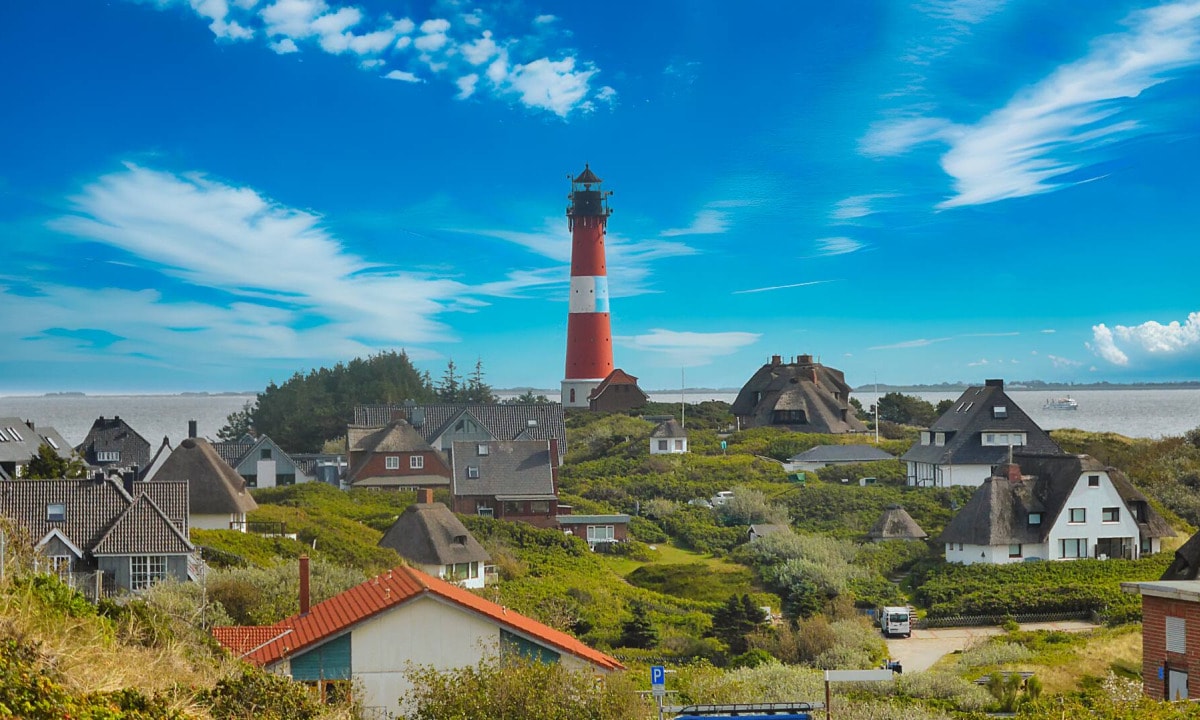 If you are looking for a picturesque, lively and fun vacation destination, the North Sea island Sylt just the thing for you! The island in front of the German coast is famous for its breathtaking views, miles of pristine beaches and exciting nightlife.
Even getting to Sylt is an adventure. You can take the train from Hamburg to Sylt, which takes about 5 hours, or you can fly to Sylt Airport, which is served by many airlines from different cities in Germany.
Once you arrive on the island, the first thing you will notice is the breathtaking landscape. The island is a nature lover's paradise with miles of sandy beaches, picturesque dunes and rolling hills. The island is best explored by bike or by car, which can be rented from many car rental companies.
One of the island's main attractions is the Wadden Sea, which has been declared a UNESCO World Heritage Site. This stunning natural wonder offers the opportunity to discover the unique flora and fauna while enjoying the fresh sea air. During a boat trip you can watch seals or observe migratory birds in their natural habitat in the bird sanctuary.
Besides the beauty of nature, Sylt is also known for its vibrant nightlife. The town of Westerland is the main attraction for visitors and here you will find numerous bars, clubs and restaurants that have something to offer for every taste. From live music to DJ sets, there is always something happening on Sylt.
When it comes to accommodation, Sylt also has something to offer for everyone. From cozy guesthouses to luxurious hotels, there is something for every budget and taste. Most hotels and guesthouses are located near the beach, so you can enjoy the sun, sand and sea during your stay.
If you are looking for a picturesque, lively and fun vacation destination, the North Sea island Sylt just the thing for you! The island in front of the German coast is famous for its breathtaking views, miles of pristine beaches and exciting nightlife.
Even getting to Sylt is an adventure. You can take the train from Hamburg to Sylt, which takes about 5 hours, or you can fly to Sylt Airport, which is served by many airlines from different cities in Germany.
Once you arrive on the island, the first thing you will notice is the breathtaking landscape. The island is a nature lover's paradise with miles of sandy beaches, picturesque dunes and rolling hills. The island is best explored by bike or by car, which can be rented from many car rental companies.
One of the island's main attractions is the Wadden Sea, which has been declared a UNESCO World Heritage Site. This stunning natural wonder offers the opportunity to discover the unique flora and fauna while enjoying the fresh sea air. During a boat trip you can watch seals or observe migratory birds in their natural habitat in the bird sanctuary.
Besides the beauty of nature, Sylt is also known for its vibrant nightlife. The town of Westerland is the main attraction for visitors and here you will find numerous bars, clubs and restaurants that have something to offer for every taste. From live music to DJ sets, there is always something happening on Sylt.
When it comes to accommodation, Sylt also has something to offer for everyone. From cozy guesthouses to luxurious hotels, there is something for every budget and taste. Most hotels and guesthouses are located near the beach, so you can enjoy the sun, sand and sea during your stay.
 Ah, Amrum. The North Sea island is a hidden gem waiting to be discovered. Those looking for a charming vacation destination with fine sandy beaches, picturesque villages and a relaxed atmosphere will feel right at home on this island.
The journey to Amrum begins with a ferry ride from the mainland. The ferry port is located in Dagebüll. There you can park your car or take the train from Hamburg to nearby Niebüll. Even the ferry ride is an experience and offers a breathtaking view of the North German coast.
Once on the island, you'll be greeted by an idyllic landscape with miles of windswept beaches, pristine dunes and striking lighthouses. Whether you are a nature lover, interested in history or simply looking for relaxation - there is a lot to see and experience on Amrum.
One of the most popular sights on the island is the historic lighthouse in Norddorf. Built in 1875, the lighthouse rises 41 meters into the air and offers a panoramic view of the North Sea and the island. A staircase leads to the top of the lighthouse, where you can enjoy the expansive view and learn about the history of the lighthouse.
Another worthwhile destination on Amrum is the village of Wittdün. Here you can explore the charming alleys with half-timbered houses and try fresh fish dishes in one of the restaurants. The town also has a beautiful beach where you can swim, sunbathe or relax with a good book.
If you want to make your vacation more active, you can go biking or hiking on the many trails of the island or try windsurfing or kitesurfing on the beaches. You can also take a whale watching tour to see seals, porpoises and other sea creatures in their natural habitat.
Amrum offers suitable accommodation for every taste and budget. You can rent a cozy vacation home or apartment in one of the charming villages of the island or stay in a hotel or guesthouse overlooking the North Sea.
Ah, Amrum. The North Sea island is a hidden gem waiting to be discovered. Those looking for a charming vacation destination with fine sandy beaches, picturesque villages and a relaxed atmosphere will feel right at home on this island.
The journey to Amrum begins with a ferry ride from the mainland. The ferry port is located in Dagebüll. There you can park your car or take the train from Hamburg to nearby Niebüll. Even the ferry ride is an experience and offers a breathtaking view of the North German coast.
Once on the island, you'll be greeted by an idyllic landscape with miles of windswept beaches, pristine dunes and striking lighthouses. Whether you are a nature lover, interested in history or simply looking for relaxation - there is a lot to see and experience on Amrum.
One of the most popular sights on the island is the historic lighthouse in Norddorf. Built in 1875, the lighthouse rises 41 meters into the air and offers a panoramic view of the North Sea and the island. A staircase leads to the top of the lighthouse, where you can enjoy the expansive view and learn about the history of the lighthouse.
Another worthwhile destination on Amrum is the village of Wittdün. Here you can explore the charming alleys with half-timbered houses and try fresh fish dishes in one of the restaurants. The town also has a beautiful beach where you can swim, sunbathe or relax with a good book.
If you want to make your vacation more active, you can go biking or hiking on the many trails of the island or try windsurfing or kitesurfing on the beaches. You can also take a whale watching tour to see seals, porpoises and other sea creatures in their natural habitat.
Amrum offers suitable accommodation for every taste and budget. You can rent a cozy vacation home or apartment in one of the charming villages of the island or stay in a hotel or guesthouse overlooking the North Sea.
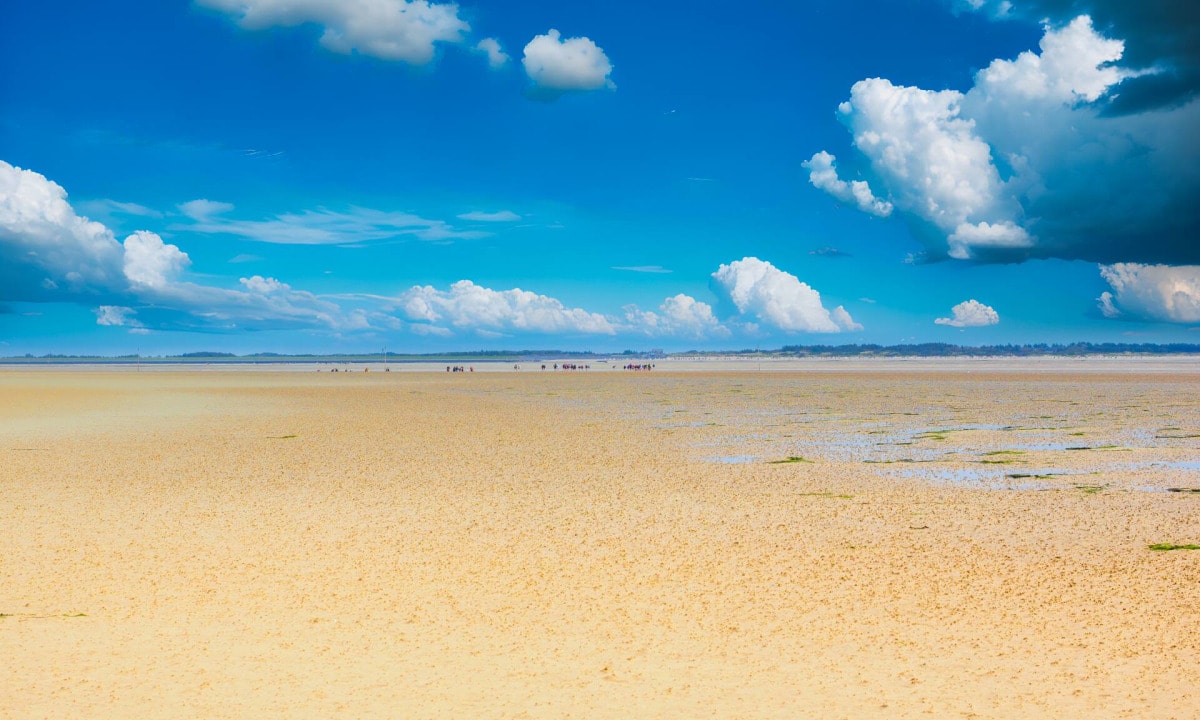 The North Frisian island of Föhr is the perfect destination for those seeking relaxation, adventure and breathtaking sights. From the moment you arrive, you will be enchanted by the island's charm, relaxed atmosphere and friendly locals. Whether alone, with family or friends, Föhr has something to offer for everyone.
Thanks to regular ferry connections from the mainland, getting to this magical island is a breeze. Those who arrive on Föhr by ferry are greeted by a sense of tranquility that immediately makes you forget the stress of modern life. The island is easy to reach by car, bike or on foot and is therefore suitable for both a day trip and a longer vacation.
Once you arrive, you can take the time to explore the island's many attractions. From the historic town center of Wyk to the stunning beaches of the Wadden Sea, there is much to see and experience. You can stroll through the charming villages of Nieblum, Oevenum or Wrixum and admire the beautiful old Frisian farmhouses. The cultural history of the island is also fascinating and can be explored in the Frisian Museum in Wyk or the Uthlande Museum in Wyk.
One of the main attractions of the North Sea island is the Wadden Sea National Park. The UNESCO World Heritage Site is a paradise for nature lovers and offers breathtaking views of the Wadden Sea, the salt marshes and sand dunes that make up this unique landscape. The Wadden Sea is home to an incredible variety of birds and marine life, and visitors can join guided tours or explore the area on their own.
A North SeaVacation on Föhr is an unforgettable experience, because there are a variety of activities that will keep you entertained during your stay. You can spend your days cycling, horseback riding, sailing or kite surfing. If you like it a bit quieter, you will find plenty of opportunities to recharge your batteries in the spas, wellness centers and on the sandy beaches of the island.
Föhr is also known for its regional cuisine with many traditional dishes made from seafood, potatoes or fresh vegetables. The island's restaurants and cafes offer a wide range of delicious dishes, from hearty meals to light snacks and refreshing drinks.
The North Frisian island of Föhr is the perfect destination for those seeking relaxation, adventure and breathtaking sights. From the moment you arrive, you will be enchanted by the island's charm, relaxed atmosphere and friendly locals. Whether alone, with family or friends, Föhr has something to offer for everyone.
Thanks to regular ferry connections from the mainland, getting to this magical island is a breeze. Those who arrive on Föhr by ferry are greeted by a sense of tranquility that immediately makes you forget the stress of modern life. The island is easy to reach by car, bike or on foot and is therefore suitable for both a day trip and a longer vacation.
Once you arrive, you can take the time to explore the island's many attractions. From the historic town center of Wyk to the stunning beaches of the Wadden Sea, there is much to see and experience. You can stroll through the charming villages of Nieblum, Oevenum or Wrixum and admire the beautiful old Frisian farmhouses. The cultural history of the island is also fascinating and can be explored in the Frisian Museum in Wyk or the Uthlande Museum in Wyk.
One of the main attractions of the North Sea island is the Wadden Sea National Park. The UNESCO World Heritage Site is a paradise for nature lovers and offers breathtaking views of the Wadden Sea, the salt marshes and sand dunes that make up this unique landscape. The Wadden Sea is home to an incredible variety of birds and marine life, and visitors can join guided tours or explore the area on their own.
A North SeaVacation on Föhr is an unforgettable experience, because there are a variety of activities that will keep you entertained during your stay. You can spend your days cycling, horseback riding, sailing or kite surfing. If you like it a bit quieter, you will find plenty of opportunities to recharge your batteries in the spas, wellness centers and on the sandy beaches of the island.
Föhr is also known for its regional cuisine with many traditional dishes made from seafood, potatoes or fresh vegetables. The island's restaurants and cafes offer a wide range of delicious dishes, from hearty meals to light snacks and refreshing drinks.
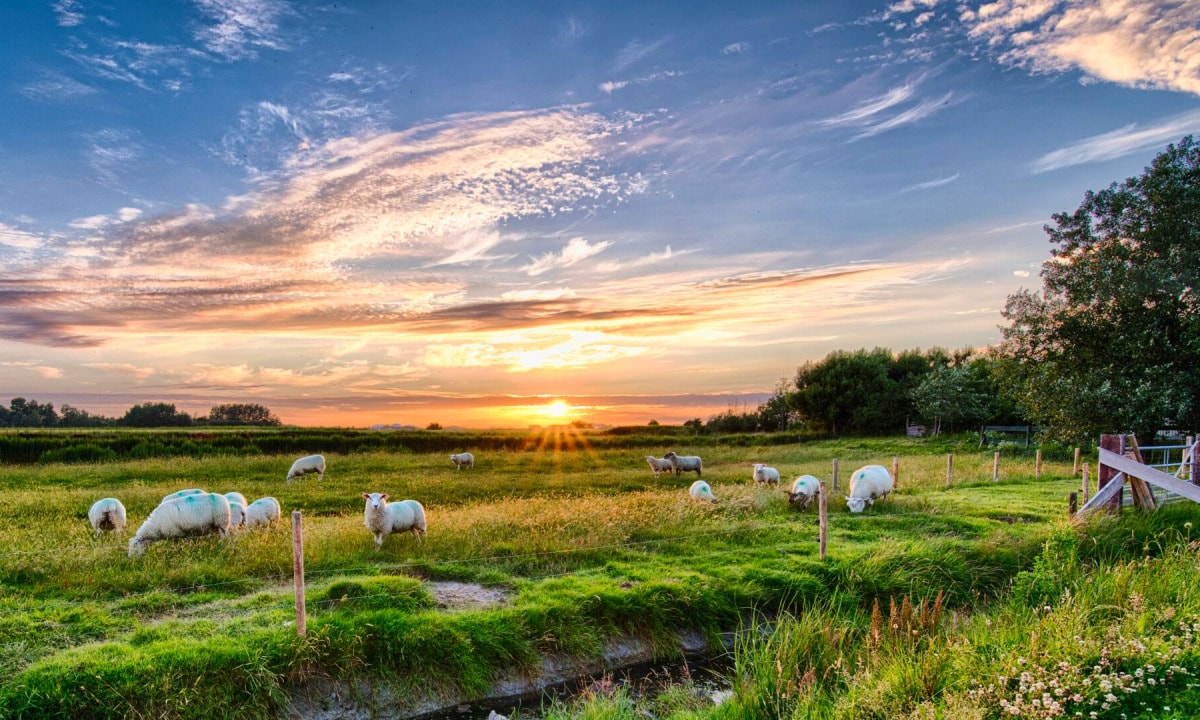 Those who are looking for a unique vacation destination are on Pellworm, one of the North Frisian North Sea Islands, just right. With a breathtaking natural landscape, a rich history and a lively atmosphere is Pellworm the perfect place for a relaxing and exciting vacation at the North Sea.
Even the journey to Pellworm is an experience. You can travel by ferry from Husum or Schlüttsiel or even by plane from Hamburg. Once there, the island welcomes you with open arms. Rustic houses and friendly locals welcome you and show you around the island.
There are many sights on Pellworm, from the traditional windmills to the old lighthouse. You can explore the island on foot or by bike and enjoy the breathtaking views of the Wadden Sea. If you are adventurous, you can even join a guided mudflat hike and explore the unique ecosystem of the Wadden Sea.
But it's not all about sightseeing. It's also a great place for a relaxing vacation on the North Sea. There are plenty of beaches to soak up the sun, and the island's wellness centers offer a variety of treatments to help you unwind. And if you are hungry, you can enjoy the delicious local cuisine with fresh fish and seafood.
One of the highlights is the Wadden Sea itself. This unique ecosystem is a UNESCO World Heritage Site and is full of wildlife. You can watch birds or even see seals on one of the many mudflat walks.
Those who are looking for a unique vacation destination are on Pellworm, one of the North Frisian North Sea Islands, just right. With a breathtaking natural landscape, a rich history and a lively atmosphere is Pellworm the perfect place for a relaxing and exciting vacation at the North Sea.
Even the journey to Pellworm is an experience. You can travel by ferry from Husum or Schlüttsiel or even by plane from Hamburg. Once there, the island welcomes you with open arms. Rustic houses and friendly locals welcome you and show you around the island.
There are many sights on Pellworm, from the traditional windmills to the old lighthouse. You can explore the island on foot or by bike and enjoy the breathtaking views of the Wadden Sea. If you are adventurous, you can even join a guided mudflat hike and explore the unique ecosystem of the Wadden Sea.
But it's not all about sightseeing. It's also a great place for a relaxing vacation on the North Sea. There are plenty of beaches to soak up the sun, and the island's wellness centers offer a variety of treatments to help you unwind. And if you are hungry, you can enjoy the delicious local cuisine with fresh fish and seafood.
One of the highlights is the Wadden Sea itself. This unique ecosystem is a UNESCO World Heritage Site and is full of wildlife. You can watch birds or even see seals on one of the many mudflat walks.
 Those who want to escape the hustle and bustle of everyday life are on North Beach just right. The picturesque North Frisian island is an oasis of natural beauty and typical coastal charm, just waiting to be discovered.
Already the journey to North Beach is an experience. As you approach the island, the sky opens up and the endless blue of the Wadden Sea welcomes you. The UNESCO World Heritage Site stretches along the coasts of Germany, the Netherlands and Denmark. The island can be reached by car, but you can also take a ferry from the mainland, which is a wonderful way to see the landscape up close.
Once on the island, there is much to see and experience. North Beach has a rich history and offers a number of attractions that reflect its past as a bustling trading center. Visitors can tour the island's historic 17th-century lighthouse or stroll through the picturesque village of Odenbüll, with its traditional thatched-roof houses and cozy cafes.
But perhaps the most beautiful thing about Nordstrand is the opportunity to simply relax and enjoy the natural beauty of the island. The Wadden Sea offers countless opportunities for outdoor recreation, from beach walks and bird watching to biking and hiking. One can also take part in a guided mudflat walk, where one can learn more about the unique ecosystem of this fragile landscape and the incredible wildlife that call it home.
Those who want to escape the hustle and bustle of everyday life are on North Beach just right. The picturesque North Frisian island is an oasis of natural beauty and typical coastal charm, just waiting to be discovered.
Already the journey to North Beach is an experience. As you approach the island, the sky opens up and the endless blue of the Wadden Sea welcomes you. The UNESCO World Heritage Site stretches along the coasts of Germany, the Netherlands and Denmark. The island can be reached by car, but you can also take a ferry from the mainland, which is a wonderful way to see the landscape up close.
Once on the island, there is much to see and experience. North Beach has a rich history and offers a number of attractions that reflect its past as a bustling trading center. Visitors can tour the island's historic 17th-century lighthouse or stroll through the picturesque village of Odenbüll, with its traditional thatched-roof houses and cozy cafes.
But perhaps the most beautiful thing about Nordstrand is the opportunity to simply relax and enjoy the natural beauty of the island. The Wadden Sea offers countless opportunities for outdoor recreation, from beach walks and bird watching to biking and hiking. One can also take part in a guided mudflat walk, where one can learn more about the unique ecosystem of this fragile landscape and the incredible wildlife that call it home.
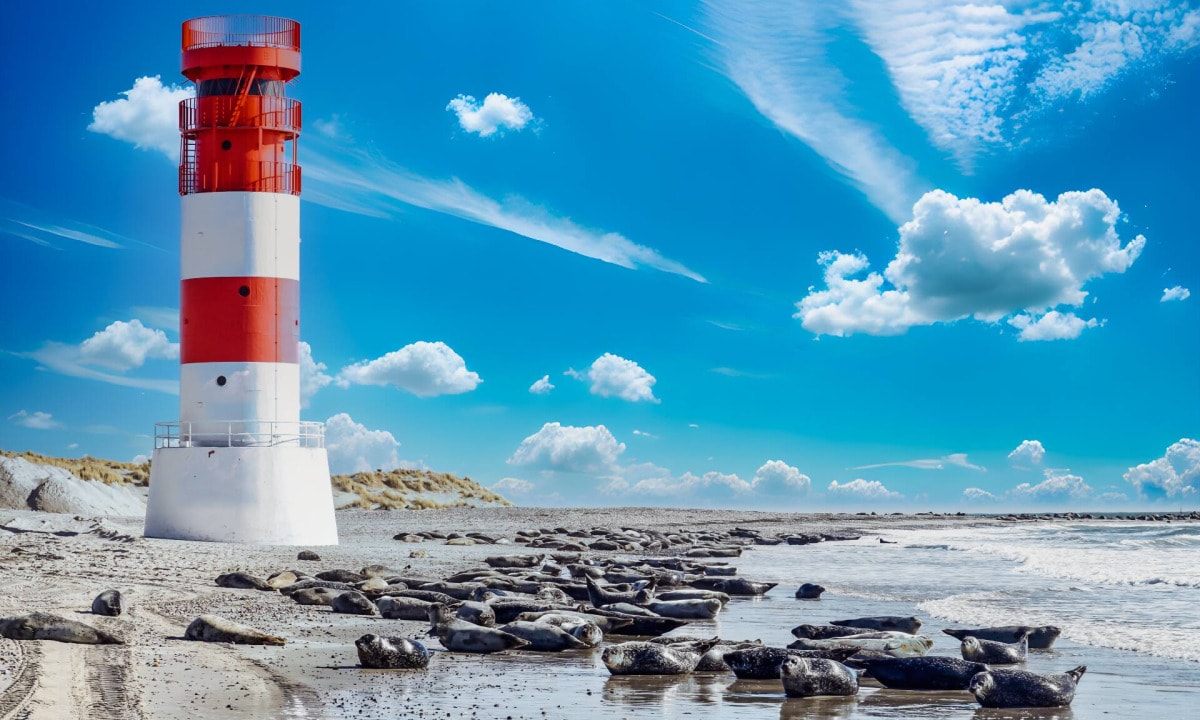 Those who travel by ferry from Heligoland comes and enters the port of Heligoland is greeted by a pleasant sea breeze and the breathtaking blue-green of the North Sea. The North German island, located 70 kilometers off the coast of Schleswig-Holstein, is a true jewel in disguise.
From its breathtaking natural beauty to its rich cultural heritage, Helgoland offers a wealth of sights and experiences you won't find anywhere else. Whether for a day trip or a longer vacation, this island paradise is guaranteed to leave a lasting impression.
One of Helgoland's highlights is the rugged cliffs with Lange Anna surrounding the island, offering some of the most dramatic coastal scenery in Europe, as well as the seal colony. A hike along the cliff path offers breathtaking views of the sea.
Another attraction is Lange Anna, which rises 47 meters above the waves. In the past it served as a navigational aid for passing ships, but today it is a popular place for bird watching and admiring the natural beauty of the island.
There is also much to discover on Helgoland for those interested in history. Due to its proximity to the coast, the island used to be a strategic naval base; remains of fortifications and bunkers can still be seen today.
Helgoland is the perfect destination for a North Sea vacation that combines relaxation and adventure. The beach on the neighboring island of Düne invites you to swim, sunbathe and enjoy water sports, while picturesque hiking trails and paths invite you to explore the rugged island landscape.
Those traveling with children should definitely visit the aquarium, which houses a variety of sea creatures such as seals, starfish and crabs. And adults can purchase luxury items such as perfume, tobacco and alcohol at reasonable prices in the island's famous duty-free stores.
Those who travel by ferry from Heligoland comes and enters the port of Heligoland is greeted by a pleasant sea breeze and the breathtaking blue-green of the North Sea. The North German island, located 70 kilometers off the coast of Schleswig-Holstein, is a true jewel in disguise.
From its breathtaking natural beauty to its rich cultural heritage, Helgoland offers a wealth of sights and experiences you won't find anywhere else. Whether for a day trip or a longer vacation, this island paradise is guaranteed to leave a lasting impression.
One of Helgoland's highlights is the rugged cliffs with Lange Anna surrounding the island, offering some of the most dramatic coastal scenery in Europe, as well as the seal colony. A hike along the cliff path offers breathtaking views of the sea.
Another attraction is Lange Anna, which rises 47 meters above the waves. In the past it served as a navigational aid for passing ships, but today it is a popular place for bird watching and admiring the natural beauty of the island.
There is also much to discover on Helgoland for those interested in history. Due to its proximity to the coast, the island used to be a strategic naval base; remains of fortifications and bunkers can still be seen today.
Helgoland is the perfect destination for a North Sea vacation that combines relaxation and adventure. The beach on the neighboring island of Düne invites you to swim, sunbathe and enjoy water sports, while picturesque hiking trails and paths invite you to explore the rugged island landscape.
Those traveling with children should definitely visit the aquarium, which houses a variety of sea creatures such as seals, starfish and crabs. And adults can purchase luxury items such as perfume, tobacco and alcohol at reasonable prices in the island's famous duty-free stores.
 If you are looking for the perfect vacation by the sea, you will find it on the East Frisian Wangerooge island just right! As soon as you arrive, you will feel the fresh sea air and the relaxed island atmosphere. Whether alone, with family or with friends, Wangerooge offers a wealth of attractions and activities that make a North Sea vacation more than just a beach trip.
The island has a rich history that is reflected in the charming red brick houses that line the streets. As soon as you step off the Wangerooge ferry that takes you to the island, you'll be greeted with stunning views of the beach, dunes, and North Sea. Take a deep breath and let the salty air fill your lungs - you've arrived in paradise!
One of the most important sights on Wangerooge is the lighthouse, which has been standing upright since 1872. You can climb its 133 steps to the top and enjoy the breathtaking panoramic view of the island and the sea. Another must-see is the Maritime Museum, which shows the maritime history and culture of the island.
The UNESCO World Heritage Wadden Sea is one of the main attractions of Wangerooge. You can take part in a guided mudflat walk and learn more about the unique ecosystem and the wildlife that lives there. The Wadden Sea is also excellent for bird watching, where you can spot rare species such as the spoonbill or the redshank.
Of course, no vacation is complete without a visit to the beach, and this beach is one of the best in the region. With a length of over 7 km, it offers plenty of space to relax, swim and play. There are also several beach bars and restaurants where you can have a drink or a meal.
If you are looking for an adventure, the North Sea island has a lot to offer. You can go cycling, windsurfing, kitesurfing or kayaking. There is also a tennis court, a golf course and a swimming pool. And if you dare, you can even try indoor skydiving!
If you are looking for the perfect vacation by the sea, you will find it on the East Frisian Wangerooge island just right! As soon as you arrive, you will feel the fresh sea air and the relaxed island atmosphere. Whether alone, with family or with friends, Wangerooge offers a wealth of attractions and activities that make a North Sea vacation more than just a beach trip.
The island has a rich history that is reflected in the charming red brick houses that line the streets. As soon as you step off the Wangerooge ferry that takes you to the island, you'll be greeted with stunning views of the beach, dunes, and North Sea. Take a deep breath and let the salty air fill your lungs - you've arrived in paradise!
One of the most important sights on Wangerooge is the lighthouse, which has been standing upright since 1872. You can climb its 133 steps to the top and enjoy the breathtaking panoramic view of the island and the sea. Another must-see is the Maritime Museum, which shows the maritime history and culture of the island.
The UNESCO World Heritage Wadden Sea is one of the main attractions of Wangerooge. You can take part in a guided mudflat walk and learn more about the unique ecosystem and the wildlife that lives there. The Wadden Sea is also excellent for bird watching, where you can spot rare species such as the spoonbill or the redshank.
Of course, no vacation is complete without a visit to the beach, and this beach is one of the best in the region. With a length of over 7 km, it offers plenty of space to relax, swim and play. There are also several beach bars and restaurants where you can have a drink or a meal.
If you are looking for an adventure, the North Sea island has a lot to offer. You can go cycling, windsurfing, kitesurfing or kayaking. There is also a tennis court, a golf course and a swimming pool. And if you dare, you can even try indoor skydiving!
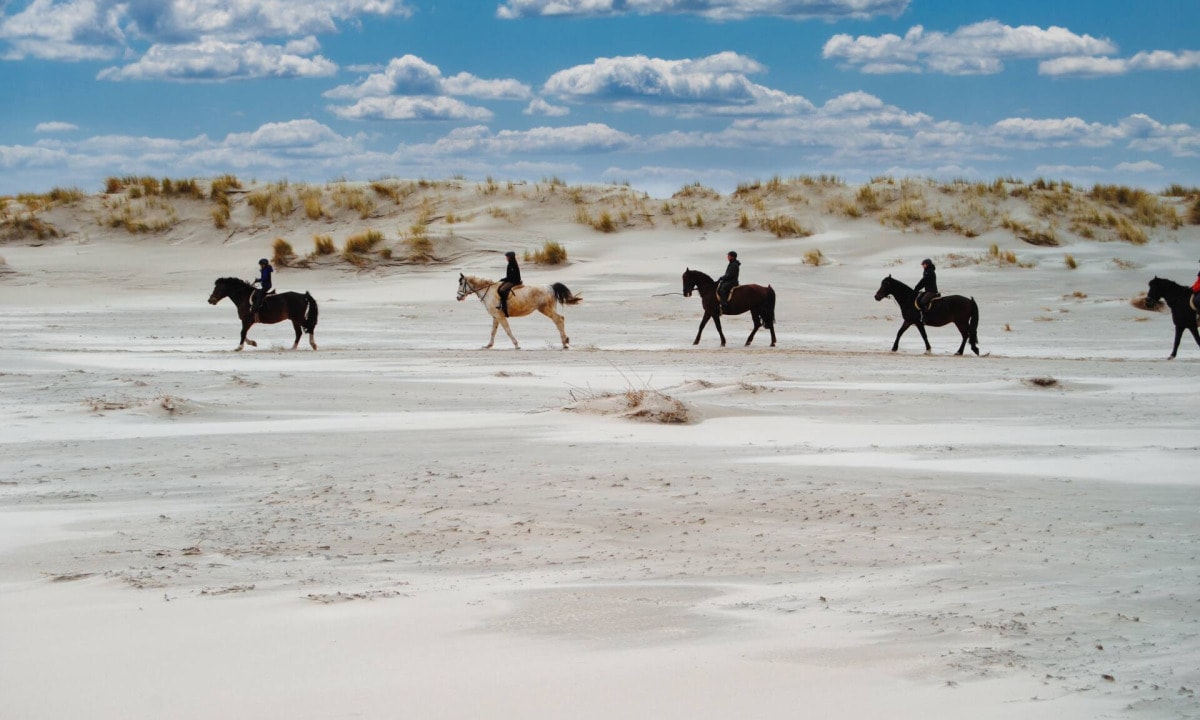 Spiekeroog - a word that includes everything that a perfect vacation resort has to offer. The beautiful and idyllic East Frisian island in the North Sea is an ideal place for those who want to spend an eventful summer vacation.
Already upon arrival at the North Sea island Spiekeroog you are greeted by a breathtaking view of the UNESCO World Heritage Wadden Sea. The island has a small harbor and can only be reached by Spiekeroog ferry or small plane.
Once there, there are plenty of sights and activities to keep you busy. The island is car-free, which means you can explore the surroundings on foot, by bike or a horse-drawn carriage. The main attraction of the island is the long sandy beach, which invites you to sunbathe, swim and surf in the summer.
Those interested in the history of the island should visit the Spiekeroog Museum, which shows the rich culture and tradition of the island. And for nature lovers, the island offers numerous opportunities for bird watching, hiking and exploring the Wadden Sea.
But what really sets the island apart from other vacation destinations is its relaxed and laid-back atmosphere. It's the perfect place to switch off, relax and recharge your batteries. Whether you're looking for a romantic getaway or a family vacation, the island has something for everyone.
During your stay on the island, you can choose from a variety of accommodations, from cozy guesthouses to luxurious hotels. And when it comes to food, Spiekeroog offers a wealth of culinary delights, from fresh seafood to traditional East Frisian dishes.
Spiekeroog - a word that includes everything that a perfect vacation resort has to offer. The beautiful and idyllic East Frisian island in the North Sea is an ideal place for those who want to spend an eventful summer vacation.
Already upon arrival at the North Sea island Spiekeroog you are greeted by a breathtaking view of the UNESCO World Heritage Wadden Sea. The island has a small harbor and can only be reached by Spiekeroog ferry or small plane.
Once there, there are plenty of sights and activities to keep you busy. The island is car-free, which means you can explore the surroundings on foot, by bike or a horse-drawn carriage. The main attraction of the island is the long sandy beach, which invites you to sunbathe, swim and surf in the summer.
Those interested in the history of the island should visit the Spiekeroog Museum, which shows the rich culture and tradition of the island. And for nature lovers, the island offers numerous opportunities for bird watching, hiking and exploring the Wadden Sea.
But what really sets the island apart from other vacation destinations is its relaxed and laid-back atmosphere. It's the perfect place to switch off, relax and recharge your batteries. Whether you're looking for a romantic getaway or a family vacation, the island has something for everyone.
During your stay on the island, you can choose from a variety of accommodations, from cozy guesthouses to luxurious hotels. And when it comes to food, Spiekeroog offers a wealth of culinary delights, from fresh seafood to traditional East Frisian dishes.
 Langeoog is a sensational island in the East Frisian Sea that you should have on your bucket list. The magical island is located in the middle of the Wadden Sea National Park and offers its visitors a unique vacation experience. From stunning sandy beaches to picturesque landscapes, it has Langeoog everything to offer.
Already the arrival is an experience. You can reach the island by Langeoog ferry or by small plane. The ferry ride is relaxing and a good opportunity to enjoy the scenic beauty of the North Sea. Once on Langeoog, you can not escape the charm of the island.
The island is car-free, so visitors can walk at their own pace and breathe in the fresh sea air. The island's main attractions include the lighthouse, the Langeoog Museum and the beach promenade. The lighthouse, which has been in operation since 1853, is a must-see for any visitor. You can climb it and enjoy the panoramic view of the surrounding landscape. In the Langeoog Museum you can learn a lot about the unique history of the island and its inhabitants. The beach promenade invites you to take a leisurely stroll and soak up the charming island atmosphere.
A Vacation on Langeoog is a unique experience. The relaxed atmosphere and natural beauty of the island invite you to unwind and recharge your batteries. Whether you want to swim, surf or just laze on the beach, everyone will find something to their liking here. But also outdoor activities such as hiking, cycling and horseback riding do not let boredom arise.
No visit to Langeoog is complete without a trip to the Wadden Sea National Park. The Wadden Sea is a UNESCO World Heritage Site and one of the largest tidal areas in the world. Visitors can take part in guided mudflat walks to learn more about this unique ecosystem and observe different bird species. A truly magical experience.
Langeoog is a sensational island in the East Frisian Sea that you should have on your bucket list. The magical island is located in the middle of the Wadden Sea National Park and offers its visitors a unique vacation experience. From stunning sandy beaches to picturesque landscapes, it has Langeoog everything to offer.
Already the arrival is an experience. You can reach the island by Langeoog ferry or by small plane. The ferry ride is relaxing and a good opportunity to enjoy the scenic beauty of the North Sea. Once on Langeoog, you can not escape the charm of the island.
The island is car-free, so visitors can walk at their own pace and breathe in the fresh sea air. The island's main attractions include the lighthouse, the Langeoog Museum and the beach promenade. The lighthouse, which has been in operation since 1853, is a must-see for any visitor. You can climb it and enjoy the panoramic view of the surrounding landscape. In the Langeoog Museum you can learn a lot about the unique history of the island and its inhabitants. The beach promenade invites you to take a leisurely stroll and soak up the charming island atmosphere.
A Vacation on Langeoog is a unique experience. The relaxed atmosphere and natural beauty of the island invite you to unwind and recharge your batteries. Whether you want to swim, surf or just laze on the beach, everyone will find something to their liking here. But also outdoor activities such as hiking, cycling and horseback riding do not let boredom arise.
No visit to Langeoog is complete without a trip to the Wadden Sea National Park. The Wadden Sea is a UNESCO World Heritage Site and one of the largest tidal areas in the world. Visitors can take part in guided mudflat walks to learn more about this unique ecosystem and observe different bird species. A truly magical experience.
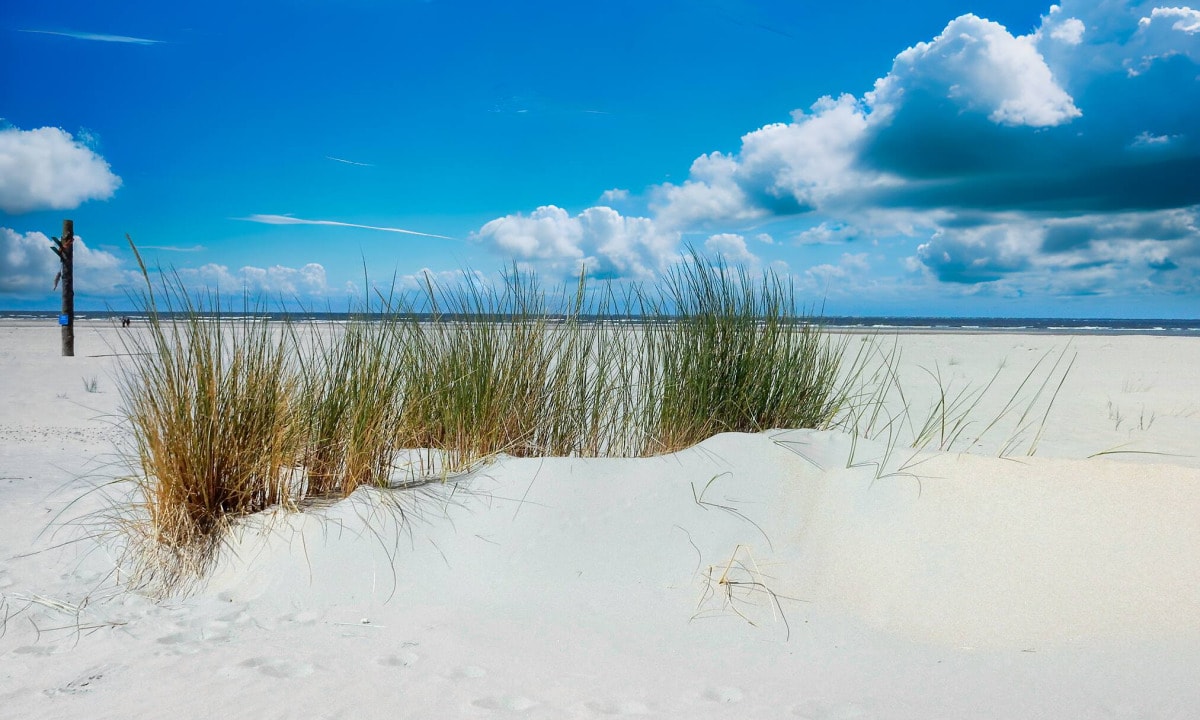 Looking for an unforgettable vacation destination in the north of Germany? Then you are on Baltrum, one of the seven East Frisian islands in the UNESCO World Heritage Wadden Sea, is just right.
The journey to Baltrum is quite simple: take the ferry from the mainland town of Neßmersiel and enjoy a 40-minute ride through the breathtaking Wadden Sea, where you can watch countless birds and seals. Look out for the island's landmark, the lighthouse, which has been guiding ships safely for more than a century.
When you arrive, you can look forward to a relaxed and charming island experience. With only 500 permanent residents, the island has a relaxed and laid-back atmosphere that is perfect for vacationers looking to get away from it all.
One of Baltrum's main attractions is its beach. It stretches for six kilometers on the eastern side of the island and is ideal for sunbathing, swimming and long walks along the coast. The water can be a bit chilly, but the magnificent view of the North Sea is well worth it.
Another place to visit is the charming island village, with its cozy cafes, restaurants serving fresh seafood, and pretty stores selling everything from handmade pottery to traditional Frisian clothing. Stroll through the village's narrow streets and admire the colorful houses and flower-filled gardens.
For nature lovers Baltrum a paradise. The island is part of the Wadden Sea National Park, a unique ecosystem with thousands of animal and plant species. During a guided mudflat walk you can discover crabs, worms and other creatures that are at home in this unique environment.
And of course, a visit to Baltrum should not be without the famous Baltrum marzipan. The sweet delicacy made of almonds, sugar and a touch of rose water is a popular local delicacy.
Looking for an unforgettable vacation destination in the north of Germany? Then you are on Baltrum, one of the seven East Frisian islands in the UNESCO World Heritage Wadden Sea, is just right.
The journey to Baltrum is quite simple: take the ferry from the mainland town of Neßmersiel and enjoy a 40-minute ride through the breathtaking Wadden Sea, where you can watch countless birds and seals. Look out for the island's landmark, the lighthouse, which has been guiding ships safely for more than a century.
When you arrive, you can look forward to a relaxed and charming island experience. With only 500 permanent residents, the island has a relaxed and laid-back atmosphere that is perfect for vacationers looking to get away from it all.
One of Baltrum's main attractions is its beach. It stretches for six kilometers on the eastern side of the island and is ideal for sunbathing, swimming and long walks along the coast. The water can be a bit chilly, but the magnificent view of the North Sea is well worth it.
Another place to visit is the charming island village, with its cozy cafes, restaurants serving fresh seafood, and pretty stores selling everything from handmade pottery to traditional Frisian clothing. Stroll through the village's narrow streets and admire the colorful houses and flower-filled gardens.
For nature lovers Baltrum a paradise. The island is part of the Wadden Sea National Park, a unique ecosystem with thousands of animal and plant species. During a guided mudflat walk you can discover crabs, worms and other creatures that are at home in this unique environment.
And of course, a visit to Baltrum should not be without the famous Baltrum marzipan. The sweet delicacy made of almonds, sugar and a touch of rose water is a popular local delicacy.
 The small East Frisian island offers an unforgettable blend of natural beauty and restful serenity and is the ideal destination for those who want to relax and enjoy the beauty of nature. Whether early morning walks on the beach or bike rides through the green meadows, Norderney has something to offer for everyone.
Already the journey to Norderney is a unique experience, because the charming island can only be reached by the Norderney-You can reach the island by ferry or by plane. The ferry is a popular and exciting way to get to this enchanting island, with the sparkling sea around you and a salty breeze in the air. When you get off the ferry, the first thing you notice is the lively atmosphere of the island. You have the possibility to rent bicycles or horses and explore the varied landscape of Norderney.
Norderney is a visual challenge where you can capture many sights with your camera. The island is home to a unique breed of sheep that roam over green fields and dunes, creating a picturesque image for photography enthusiasts. The Kurhaus, Norderney's landmark, is another sight to see with its impressive architecture and breathtaking views over the island. The lighthouse is also unique and the view from above is simply spectacular.
Norderney offers a fantastic variety of activities and countless ways to enjoy the island - from cycling through the dunes to swimming in the North Sea. Especially popular with tourists are mudflat walks, where you can experience the Wadden Sea up close and enjoy its beauty. The Wadden Sea is a unique ecosystem and a hike through mud and sand can be an exciting and unforgettable experience.
A North Sea vacation here is all about relaxation, and the island's laid-back atmosphere is perfect for unwinding and relieving stress. Whether you're lounging on the beach with your favorite book or enjoying the delicious local cuisine, vacationing is perfect for letting go and relaxing.
The small East Frisian island offers an unforgettable blend of natural beauty and restful serenity and is the ideal destination for those who want to relax and enjoy the beauty of nature. Whether early morning walks on the beach or bike rides through the green meadows, Norderney has something to offer for everyone.
Already the journey to Norderney is a unique experience, because the charming island can only be reached by the Norderney-You can reach the island by ferry or by plane. The ferry is a popular and exciting way to get to this enchanting island, with the sparkling sea around you and a salty breeze in the air. When you get off the ferry, the first thing you notice is the lively atmosphere of the island. You have the possibility to rent bicycles or horses and explore the varied landscape of Norderney.
Norderney is a visual challenge where you can capture many sights with your camera. The island is home to a unique breed of sheep that roam over green fields and dunes, creating a picturesque image for photography enthusiasts. The Kurhaus, Norderney's landmark, is another sight to see with its impressive architecture and breathtaking views over the island. The lighthouse is also unique and the view from above is simply spectacular.
Norderney offers a fantastic variety of activities and countless ways to enjoy the island - from cycling through the dunes to swimming in the North Sea. Especially popular with tourists are mudflat walks, where you can experience the Wadden Sea up close and enjoy its beauty. The Wadden Sea is a unique ecosystem and a hike through mud and sand can be an exciting and unforgettable experience.
A North Sea vacation here is all about relaxation, and the island's laid-back atmosphere is perfect for unwinding and relieving stress. Whether you're lounging on the beach with your favorite book or enjoying the delicious local cuisine, vacationing is perfect for letting go and relaxing.
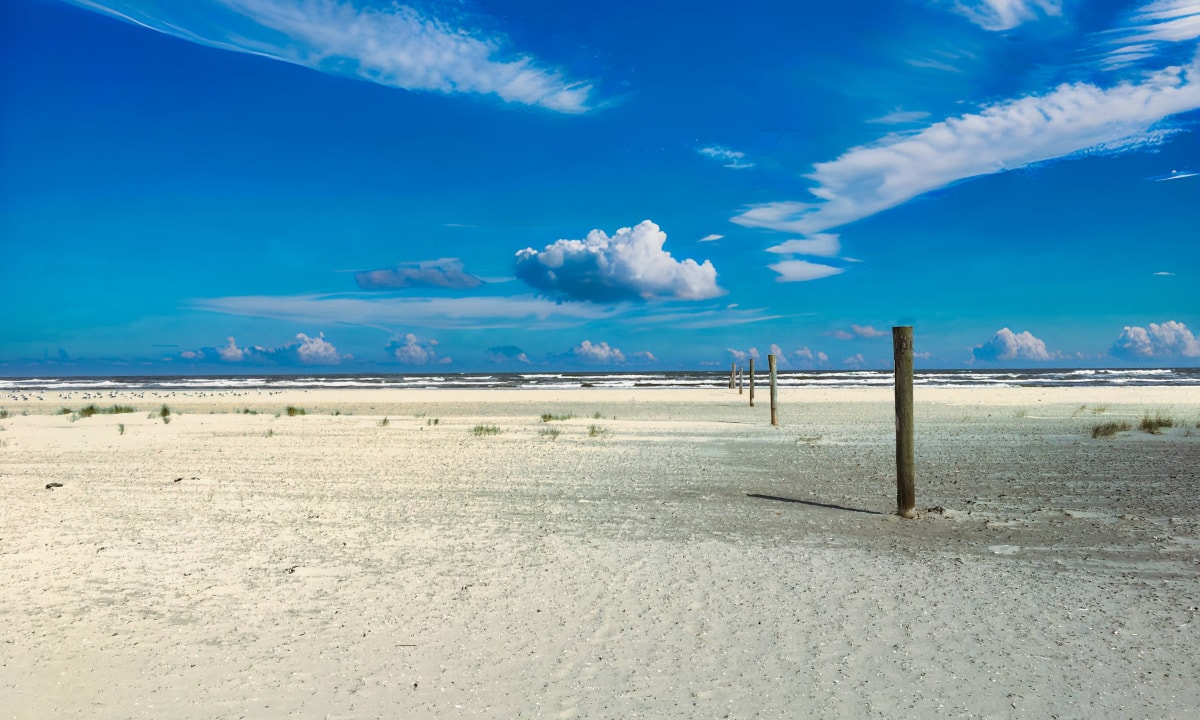 Also the East Frisian Juist island is an option for summer vacation. The first thing you notice is that there are no cars on the island, which adds to the feeling of peace and relaxation. Instead, you can hear the soft clatter of horses pulling the carriages that take visitors around the island.
Juist has a lot to offer, from stunning beaches to quaint stores. One of the highlights of any visit to Juist is a walk along the Wadden Sea, which has been declared a UNESCO World Heritage Site and is home to a variety of animal and plant species.
But it's not just the sights that make Juist a perfect vacation destination. The island also has a thriving cultural scene with music and theater performances, art exhibitions and other events taking place throughout the year.
To enjoy a Vacation on Juist to enjoy, you have to get involved with the laid-back life on the island. Relax on the beach, take a leisurely stroll through the town, or just sit and watch the world go by. Whatever you do, you'll definitely feel refreshed and rejuvenated.
Also the East Frisian Juist island is an option for summer vacation. The first thing you notice is that there are no cars on the island, which adds to the feeling of peace and relaxation. Instead, you can hear the soft clatter of horses pulling the carriages that take visitors around the island.
Juist has a lot to offer, from stunning beaches to quaint stores. One of the highlights of any visit to Juist is a walk along the Wadden Sea, which has been declared a UNESCO World Heritage Site and is home to a variety of animal and plant species.
But it's not just the sights that make Juist a perfect vacation destination. The island also has a thriving cultural scene with music and theater performances, art exhibitions and other events taking place throughout the year.
To enjoy a Vacation on Juist to enjoy, you have to get involved with the laid-back life on the island. Relax on the beach, take a leisurely stroll through the town, or just sit and watch the world go by. Whatever you do, you'll definitely feel refreshed and rejuvenated.
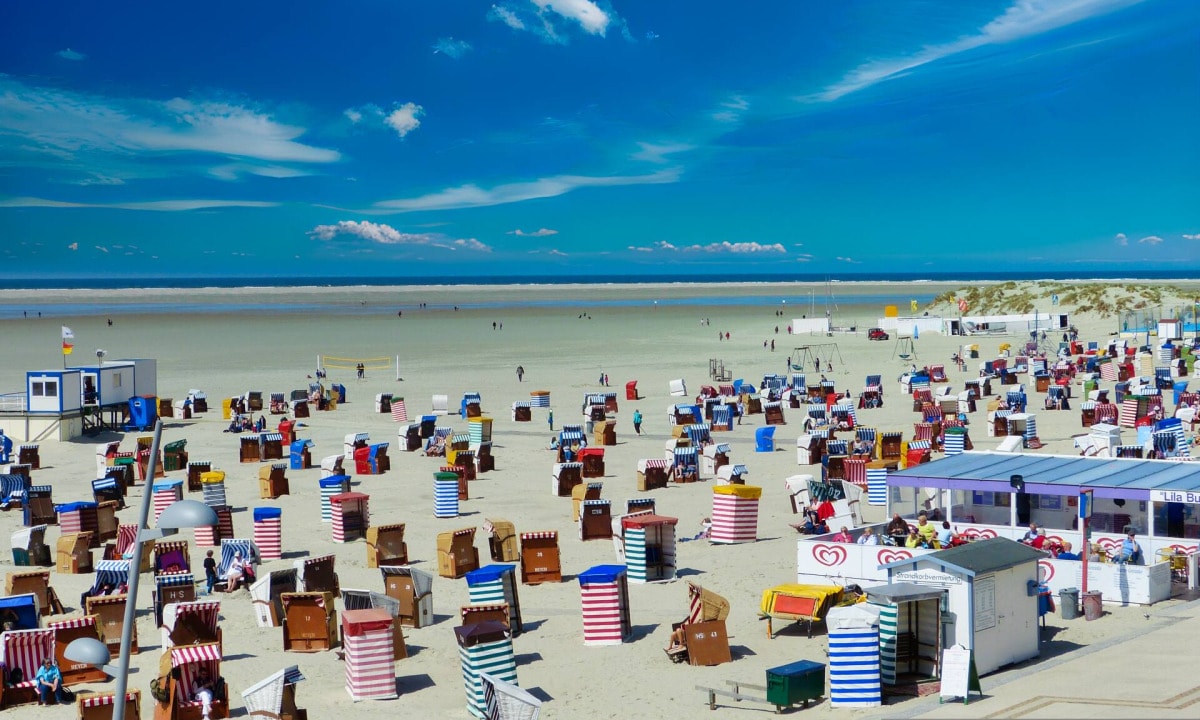 Planning your next vacation and looking for a destination with pristine beaches, stunning scenery and a lively atmosphere? Then the East Frisian North Sea island Borkum just the thing for you!
As soon as you arrive on the island, you know you have something special to look forward to. The excitement starts as soon as you catch the ferry from the mainland to Borkum climb. The closer you get to the island, the greater the anticipation and the more you feel the excitement that awaits you.
Once there, a variety of sights and activities await you that will make your vacation unforgettable. Borkum is known for its stunning coastline with long, white sandy beaches that invite you to sunbathe or take a refreshing dip in the sea. In addition to the beaches, the island also offers a variety of activities such as cycling, hiking and horseback riding, to name a few. The landscape of the island is a mixture of dunes, forests and moors and is perfect for hiking and biking.
A special feature is its location in the Wadden Sea National Park. This beautiful UNESCO World Heritage Site can be explored on guided tours, trudging through the mudflats and experiencing the rhythm of the tides.
For an active vacation, there are numerous sports facilities such as tennis courts, golf courses and a climbing park. The island is also ideal for water sports such as kite surfing, sailing and windsurfing. But that's not all! The island has a rich cultural offer with numerous events throughout the year. From concerts to theater performances, there is something for everyone. You can also visit the many museums and galleries that showcase local art and history.
Borkum offers accommodations for every budget, whether you are looking for a cozy bed & breakfast or a luxurious hotel. In the numerous restaurants and beach bars of the island you can fortify yourself with fresh and delicious food after an eventful day.
Planning your next vacation and looking for a destination with pristine beaches, stunning scenery and a lively atmosphere? Then the East Frisian North Sea island Borkum just the thing for you!
As soon as you arrive on the island, you know you have something special to look forward to. The excitement starts as soon as you catch the ferry from the mainland to Borkum climb. The closer you get to the island, the greater the anticipation and the more you feel the excitement that awaits you.
Once there, a variety of sights and activities await you that will make your vacation unforgettable. Borkum is known for its stunning coastline with long, white sandy beaches that invite you to sunbathe or take a refreshing dip in the sea. In addition to the beaches, the island also offers a variety of activities such as cycling, hiking and horseback riding, to name a few. The landscape of the island is a mixture of dunes, forests and moors and is perfect for hiking and biking.
A special feature is its location in the Wadden Sea National Park. This beautiful UNESCO World Heritage Site can be explored on guided tours, trudging through the mudflats and experiencing the rhythm of the tides.
For an active vacation, there are numerous sports facilities such as tennis courts, golf courses and a climbing park. The island is also ideal for water sports such as kite surfing, sailing and windsurfing. But that's not all! The island has a rich cultural offer with numerous events throughout the year. From concerts to theater performances, there is something for everyone. You can also visit the many museums and galleries that showcase local art and history.
Borkum offers accommodations for every budget, whether you are looking for a cozy bed & breakfast or a luxurious hotel. In the numerous restaurants and beach bars of the island you can fortify yourself with fresh and delicious food after an eventful day.
 You are planning a long-awaited vacation at the German North Sea? Then you might ask yourself: Should I stay in a vacation apartment? But don't worry! Here you will find a list of pros and cons to help you decide.
Advantages: Freedom and flexibility
The best thing about a vacation rental is the freedom and flexibility it gives you. You can come and go as you please, cook your own meals and enjoy the space and privacy you wouldn't have in a hotel room. Plus, you can choose an apartment that suits your needs and preferences - from a cozy studio to a spacious family suite.
Cons: Limited service
With all the freedom, of course, comes the responsibility to take care of yourself. Unlike hotels, vacation apartments don't have 24-hour room service or daily housekeeping. You have to cook, clean and wash yourself, which is not necessarily everyone's idea of a relaxing vacation.
Pro: Cost effective
Renting a vacation home can be cheaper than staying in a hotel. For example, if you are traveling with a group or family, you can share the rent and save on meals by cooking for yourself. Also, some apartments offer discounts for longer stays, which is a great way to stay on budget.
Cons: Location and equipment
Another factor you should consider is the location and facilities of the apartment. Some apartments are further away from the beach or the city center, which is not ideal if you are looking for a central location. Also, you may not have access to facilities such as a swimming pool or a fitness center, which can be a disadvantage for some travelers.
You are planning a long-awaited vacation at the German North Sea? Then you might ask yourself: Should I stay in a vacation apartment? But don't worry! Here you will find a list of pros and cons to help you decide.
Advantages: Freedom and flexibility
The best thing about a vacation rental is the freedom and flexibility it gives you. You can come and go as you please, cook your own meals and enjoy the space and privacy you wouldn't have in a hotel room. Plus, you can choose an apartment that suits your needs and preferences - from a cozy studio to a spacious family suite.
Cons: Limited service
With all the freedom, of course, comes the responsibility to take care of yourself. Unlike hotels, vacation apartments don't have 24-hour room service or daily housekeeping. You have to cook, clean and wash yourself, which is not necessarily everyone's idea of a relaxing vacation.
Pro: Cost effective
Renting a vacation home can be cheaper than staying in a hotel. For example, if you are traveling with a group or family, you can share the rent and save on meals by cooking for yourself. Also, some apartments offer discounts for longer stays, which is a great way to stay on budget.
Cons: Location and equipment
Another factor you should consider is the location and facilities of the apartment. Some apartments are further away from the beach or the city center, which is not ideal if you are looking for a central location. Also, you may not have access to facilities such as a swimming pool or a fitness center, which can be a disadvantage for some travelers.
 Vacation homes on the North Sea offer a unique opportunity to experience the beauty and tranquility of the North Sea while enjoying the comforts of home.
There are different types of vacation homes, from small apartments to luxurious villas. Many of these houses are located near the beach and offer easy access to the sea and breathtaking views of the coast.
One of the biggest advantages of vacation homes is their flexibility. Unlike hotels, in a vacation home you can determine your own daily routine and live independently. You can prepare your own meals in a fully equipped kitchen, use a private outdoor area and relax in a spacious living room.
Another advantage is the price. For large families or groups of friends, renting a vacation home can be much cheaper than staying in a hotel. You can share the rental costs and save money on meals by cooking at home.
However, there are some disadvantages as well. For example, you have to keep the house clean and tidy throughout your stay. This is more stressful than in a hotel room, where housekeeping takes care of everything.
Also, vacation homes can be lonelier than hotels. If you're looking for a lively atmosphere and lots of social interaction, a hotel may be a better choice. However, if you prefer a quiet and peaceful environment, a vacation home may be the perfect choice.
When you book a vacation home for your North Sea vacation, you'll typically have access to a number of amenities, including a fully equipped kitchen, a large living room, and an outdoor area for dining and relaxing. Many vacation homes also have access to a communal pool or playground, making them ideal for families with children.
Vacation homes on the North Sea offer a unique opportunity to experience the beauty and tranquility of the North Sea while enjoying the comforts of home.
There are different types of vacation homes, from small apartments to luxurious villas. Many of these houses are located near the beach and offer easy access to the sea and breathtaking views of the coast.
One of the biggest advantages of vacation homes is their flexibility. Unlike hotels, in a vacation home you can determine your own daily routine and live independently. You can prepare your own meals in a fully equipped kitchen, use a private outdoor area and relax in a spacious living room.
Another advantage is the price. For large families or groups of friends, renting a vacation home can be much cheaper than staying in a hotel. You can share the rental costs and save money on meals by cooking at home.
However, there are some disadvantages as well. For example, you have to keep the house clean and tidy throughout your stay. This is more stressful than in a hotel room, where housekeeping takes care of everything.
Also, vacation homes can be lonelier than hotels. If you're looking for a lively atmosphere and lots of social interaction, a hotel may be a better choice. However, if you prefer a quiet and peaceful environment, a vacation home may be the perfect choice.
When you book a vacation home for your North Sea vacation, you'll typically have access to a number of amenities, including a fully equipped kitchen, a large living room, and an outdoor area for dining and relaxing. Many vacation homes also have access to a communal pool or playground, making them ideal for families with children.
 Pro: The great outdoors
Camping is above all a return to nature, and the North Sea coast is the perfect playground for outdoor enthusiasts. There are miles of coastline with breathtaking views, sandy beaches and endless opportunities for fishing, swimming and boating. You can also hike through the dunes, explore hidden coves and estuaries, and observe wildlife.
Contra: The weather
The North Sea coast and the North Sea islands are known for their unpredictable weather. Even in summer, the weather can be unpredictable, as sunny spells are often followed by strong winds, rain showers and even thunderstorms. So you should be prepared for all weather conditions and pack accordingly.
Pro: Cheap vacation
One of the biggest advantages of camping on the German North Sea is that it's a cheap vacation option. A pitch at a campsite can be had for just a few euros a night, and if you cook for yourself and bring your own supplies, you can save money.
Cons: Overcrowded campsites
At the height of summer, many campgrounds can be crowded and you may have to share a space with other campers. You may also have to queue for showers and toilets and there may be noise from neighboring campsites. However, this can easily be avoided by choosing a quieter site or camping out of season.
Pro: Fun for the whole family
Camping is a great way to spend time with the family. Children can play outside, make new friends and learn about nature. Many campsites also offer activities such as archery, horseback riding and water sports.
Cons: Limited comfort
Camping is not always the most comfortable solution. You may have to sleep on the ground, deal with insects and get used to using communal toilets and showers. But this can be easily avoided by choosing accommodation with more comfort or bringing your own camping equipment.
Despite the drawbacks, camping on the North Sea islands can be a beautiful and unforgettable experience. The miles of stunning coastline, beautiful nature and affordable prices are a great way to get away from it all and rediscover nature. So, pitch your tent, pack up your family or friends and let's go!
Pro: The great outdoors
Camping is above all a return to nature, and the North Sea coast is the perfect playground for outdoor enthusiasts. There are miles of coastline with breathtaking views, sandy beaches and endless opportunities for fishing, swimming and boating. You can also hike through the dunes, explore hidden coves and estuaries, and observe wildlife.
Contra: The weather
The North Sea coast and the North Sea islands are known for their unpredictable weather. Even in summer, the weather can be unpredictable, as sunny spells are often followed by strong winds, rain showers and even thunderstorms. So you should be prepared for all weather conditions and pack accordingly.
Pro: Cheap vacation
One of the biggest advantages of camping on the German North Sea is that it's a cheap vacation option. A pitch at a campsite can be had for just a few euros a night, and if you cook for yourself and bring your own supplies, you can save money.
Cons: Overcrowded campsites
At the height of summer, many campgrounds can be crowded and you may have to share a space with other campers. You may also have to queue for showers and toilets and there may be noise from neighboring campsites. However, this can easily be avoided by choosing a quieter site or camping out of season.
Pro: Fun for the whole family
Camping is a great way to spend time with the family. Children can play outside, make new friends and learn about nature. Many campsites also offer activities such as archery, horseback riding and water sports.
Cons: Limited comfort
Camping is not always the most comfortable solution. You may have to sleep on the ground, deal with insects and get used to using communal toilets and showers. But this can be easily avoided by choosing accommodation with more comfort or bringing your own camping equipment.
Despite the drawbacks, camping on the North Sea islands can be a beautiful and unforgettable experience. The miles of stunning coastline, beautiful nature and affordable prices are a great way to get away from it all and rediscover nature. So, pitch your tent, pack up your family or friends and let's go!
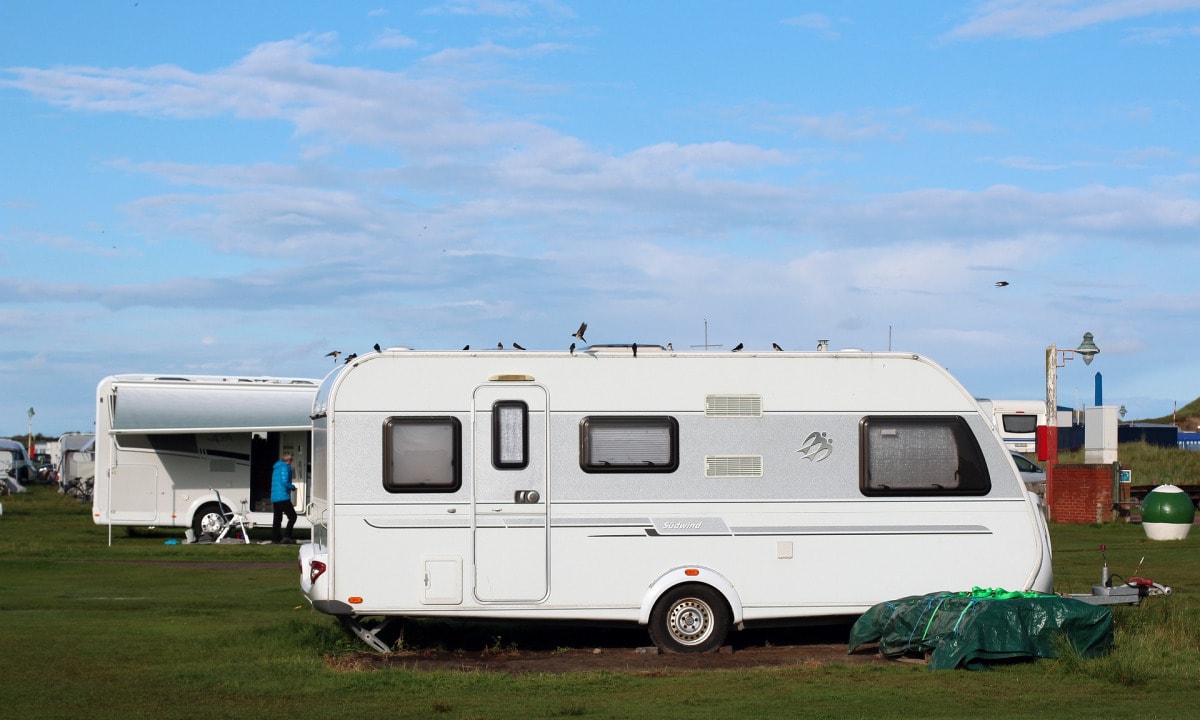 Before you pack up your motorhome and head out, you should be aware of the pros and cons of a motorhome vacation on the German North Sea.
Pro: Freedom and flexibility
One of the greatest advantages of a motorhome vacation is the freedom and flexibility it offers. You can go where you want, stop when you want, and stay as long as you want. Whether you want to explore the coast, visit historic towns, or just relax on the beach, an RV vacation gives you the freedom to do everything at your own pace.
Disadvantage: Limited space
The downside is that it can be quite cramped in a motorhome, especially if you are traveling with more than two people. You have to carry light luggage and be prepared to share a small living and sleeping area. But with a little planning and organization, you can make the most of the limited space and enjoy a comfortable and cozy vacation.
Pro: Beautiful landscapes and breathtaking views
One of the best aspects is the opportunity to explore the countryside from the car and enjoy breathtaking views. Along the German North Sea coast there are miles of beautiful coastline, rolling hills and charming villages that are perfect for exploring by motorhome.
Disadvantage: Driving and navigation problems
Driving can be a challenge, especially if you're not used to dealing with such a large and unwieldy vehicle. You have to deal with narrow roads, steep hills, sharp turns and face the challenges of parking in campgrounds. But with practice and patience, you can master the art and enjoy all the benefits this type of vacation has to offer.
Pro: Affordable accommodation
Compared to traditional hotels and resorts, camping can be very affordable, especially if you're willing to risk a little more. You can save money on accommodation, food and entertainment and still enjoy the comforts of home.
Disadvantage: Maintenance and assembly
Unfortunately, RVs require some maintenance and setup that can be time-consuming and difficult. From filling the water tanks to emptying the waste water tanks, you have to be prepared to take care of the vehicle on a daily basis. Setting up and breaking down the campsite can also be tedious, especially if you are traveling with children or pets.
Before you pack up your motorhome and head out, you should be aware of the pros and cons of a motorhome vacation on the German North Sea.
Pro: Freedom and flexibility
One of the greatest advantages of a motorhome vacation is the freedom and flexibility it offers. You can go where you want, stop when you want, and stay as long as you want. Whether you want to explore the coast, visit historic towns, or just relax on the beach, an RV vacation gives you the freedom to do everything at your own pace.
Disadvantage: Limited space
The downside is that it can be quite cramped in a motorhome, especially if you are traveling with more than two people. You have to carry light luggage and be prepared to share a small living and sleeping area. But with a little planning and organization, you can make the most of the limited space and enjoy a comfortable and cozy vacation.
Pro: Beautiful landscapes and breathtaking views
One of the best aspects is the opportunity to explore the countryside from the car and enjoy breathtaking views. Along the German North Sea coast there are miles of beautiful coastline, rolling hills and charming villages that are perfect for exploring by motorhome.
Disadvantage: Driving and navigation problems
Driving can be a challenge, especially if you're not used to dealing with such a large and unwieldy vehicle. You have to deal with narrow roads, steep hills, sharp turns and face the challenges of parking in campgrounds. But with practice and patience, you can master the art and enjoy all the benefits this type of vacation has to offer.
Pro: Affordable accommodation
Compared to traditional hotels and resorts, camping can be very affordable, especially if you're willing to risk a little more. You can save money on accommodation, food and entertainment and still enjoy the comforts of home.
Disadvantage: Maintenance and assembly
Unfortunately, RVs require some maintenance and setup that can be time-consuming and difficult. From filling the water tanks to emptying the waste water tanks, you have to be prepared to take care of the vehicle on a daily basis. Setting up and breaking down the campsite can also be tedious, especially if you are traveling with children or pets.
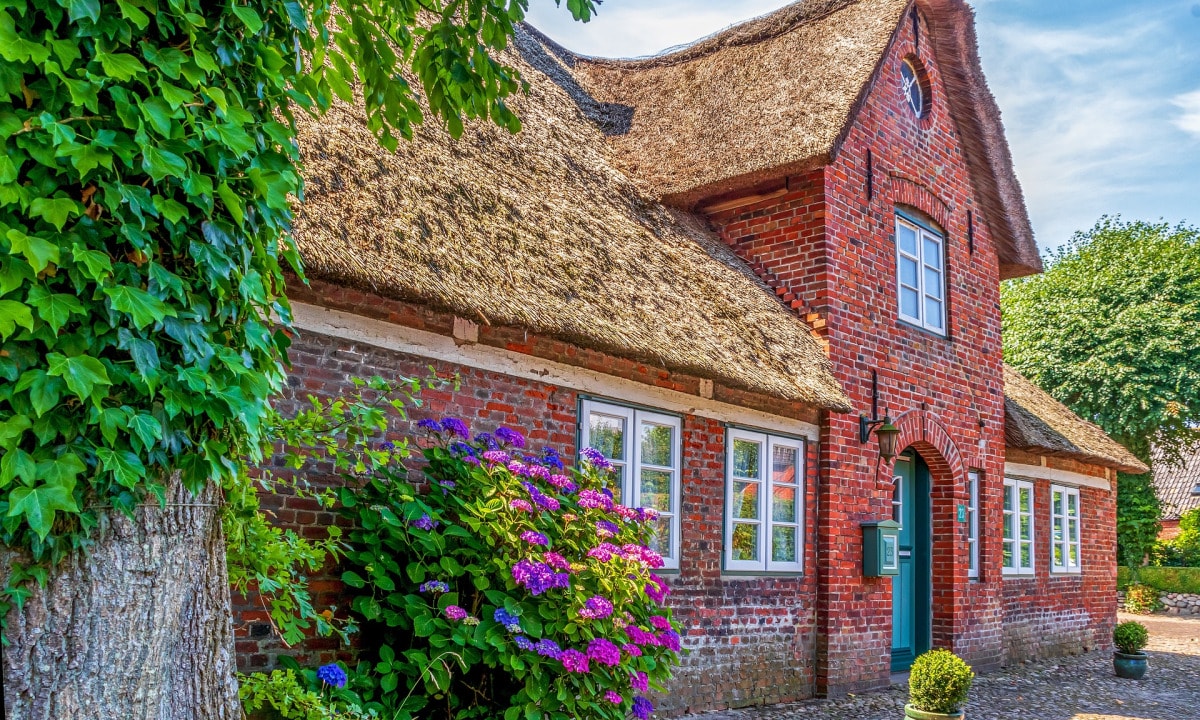 North Sea vacation rentals are a popular choice for tourists who want to relax and unwind. These accommodations offer a number of benefits and amenities that can make your vacation unforgettable. However, there are also some disadvantages that can tarnish the overall experience.
First, vacation boarding houses make you feel at home. The rooms are often spacious and comfortable, and many have a balcony or terrace with a beautiful sea view. Here you can enjoy the fresh sea breeze while having your morning coffee or watch the sunset in the evening. In addition, the apartments offer a range of facilities and services to ensure guests a pleasant stay. These include free Wi-Fi, parking, bike rental and even spa treatments.
Another advantage is the location. They are often located in quaint coastal towns and villages, so guests can easily reach the beach, stores and restaurants. You can take a leisurely stroll along the boardwalk, swim in the sea, or explore the surrounding area on foot or by bike. The North Sea region is known for its natural beauty and the apartments are an ideal starting point to explore it.
Now to the disadvantages. One of the biggest disadvantages is that they can be very expensive, especially in high season. You may have to pay a premium for the location and amenities, which can break your budget. Also, they can be crowded in high season and you have to share facilities like the pool or sunbeds with other guests.
Another potential drawback is that vacation guesthouses sometimes lack character and individuality. They often belong to larger chains or groups, which can make them impersonal. You don't get the same personal service and attention as you would in a smaller or independent accommodation. However, this is not true of all hostels and many offer a unique and memorable experience.
North Sea vacation rentals are a popular choice for tourists who want to relax and unwind. These accommodations offer a number of benefits and amenities that can make your vacation unforgettable. However, there are also some disadvantages that can tarnish the overall experience.
First, vacation boarding houses make you feel at home. The rooms are often spacious and comfortable, and many have a balcony or terrace with a beautiful sea view. Here you can enjoy the fresh sea breeze while having your morning coffee or watch the sunset in the evening. In addition, the apartments offer a range of facilities and services to ensure guests a pleasant stay. These include free Wi-Fi, parking, bike rental and even spa treatments.
Another advantage is the location. They are often located in quaint coastal towns and villages, so guests can easily reach the beach, stores and restaurants. You can take a leisurely stroll along the boardwalk, swim in the sea, or explore the surrounding area on foot or by bike. The North Sea region is known for its natural beauty and the apartments are an ideal starting point to explore it.
Now to the disadvantages. One of the biggest disadvantages is that they can be very expensive, especially in high season. You may have to pay a premium for the location and amenities, which can break your budget. Also, they can be crowded in high season and you have to share facilities like the pool or sunbeds with other guests.
Another potential drawback is that vacation guesthouses sometimes lack character and individuality. They often belong to larger chains or groups, which can make them impersonal. You don't get the same personal service and attention as you would in a smaller or independent accommodation. However, this is not true of all hostels and many offer a unique and memorable experience.
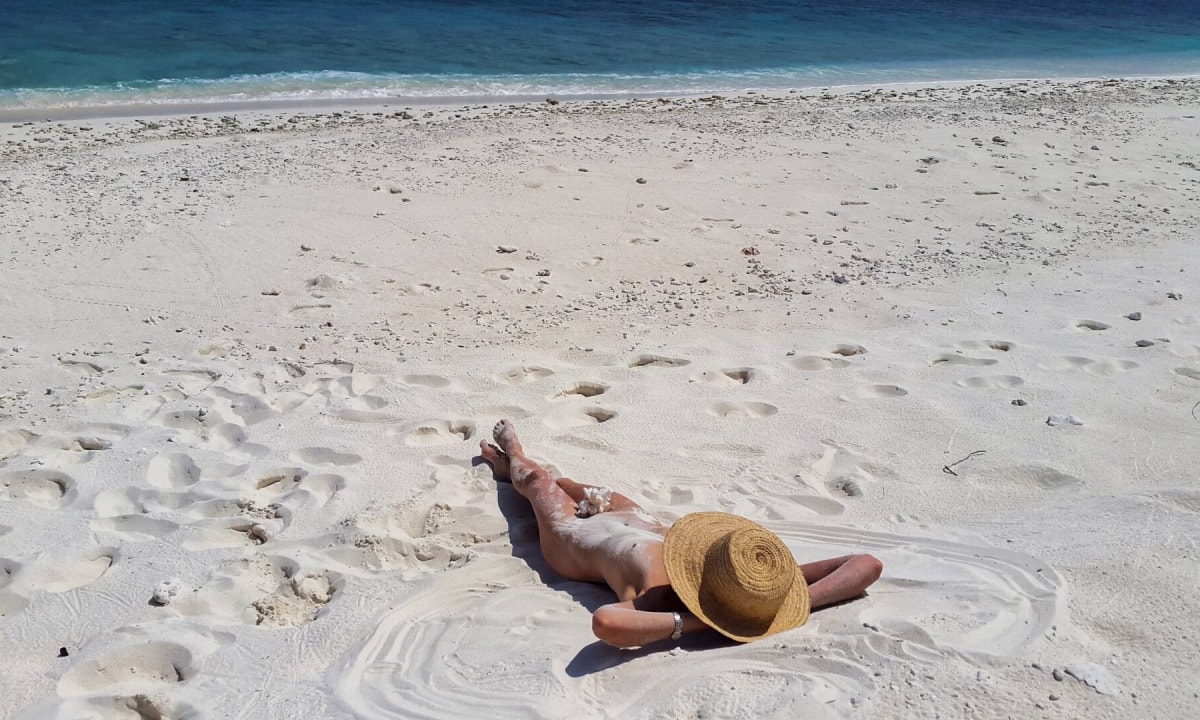 Whether you're a true nudist or just want to get away from it all, the nudist beaches on the North Sea offer you a refreshing and invigorating experience. Imagine lying in the warm sun, feeling the sea breeze on your skin and swimming in the soothing water, without the constraints of clothing. This feeling of freedom and self-realization is truly unmatched.
The best thing about the nudist beaches on the North Sea is the lively and welcoming community of like-minded people you will meet there. You'll find that everyone is friendly, open and accepting, regardless of your body type, age or background. It's an inclusive and supportive environment where you can truly be yourself.
If you are hesitant to be naked in public, don't be ashamed. For many people, nudity is simply a natural and comfortable way to show yourself and has nothing to do with sexuality or provocation. You quickly realize that after a few minutes of undressing, you forgot that you had anything on at all.
For some, a visit to the North Sea means taking part in a unique aspect of German culture - a FKK vacation. FKK stands for "Freikörperkultur" (nudist culture) and refers to a type of vacation at the North Sea where you don't have to be clothed. Here are some advantages and disadvantages of a nudist vacation at the German North Sea:
Pro: A sense of liberation
For many people, a nudist vacation can be an incredibly liberating experience. When you take off your clothes, you also shed the fears and insecurities associated with them. You can feel free to be yourself and enjoy the beautiful nature without worrying about what others think.
Cons: Discomfort
Even though it is a unique and exciting experience, you should think twice about whether a nudist vacation is right for you. Without clothing, you may feel uncomfortable or unprotected, especially in public places where there are many people around you. Make sure you are ready for the experience before you go for it.
Whether you're a true nudist or just want to get away from it all, the nudist beaches on the North Sea offer you a refreshing and invigorating experience. Imagine lying in the warm sun, feeling the sea breeze on your skin and swimming in the soothing water, without the constraints of clothing. This feeling of freedom and self-realization is truly unmatched.
The best thing about the nudist beaches on the North Sea is the lively and welcoming community of like-minded people you will meet there. You'll find that everyone is friendly, open and accepting, regardless of your body type, age or background. It's an inclusive and supportive environment where you can truly be yourself.
If you are hesitant to be naked in public, don't be ashamed. For many people, nudity is simply a natural and comfortable way to show yourself and has nothing to do with sexuality or provocation. You quickly realize that after a few minutes of undressing, you forgot that you had anything on at all.
For some, a visit to the North Sea means taking part in a unique aspect of German culture - a FKK vacation. FKK stands for "Freikörperkultur" (nudist culture) and refers to a type of vacation at the North Sea where you don't have to be clothed. Here are some advantages and disadvantages of a nudist vacation at the German North Sea:
Pro: A sense of liberation
For many people, a nudist vacation can be an incredibly liberating experience. When you take off your clothes, you also shed the fears and insecurities associated with them. You can feel free to be yourself and enjoy the beautiful nature without worrying about what others think.
Cons: Discomfort
Even though it is a unique and exciting experience, you should think twice about whether a nudist vacation is right for you. Without clothing, you may feel uncomfortable or unprotected, especially in public places where there are many people around you. Make sure you are ready for the experience before you go for it.
 The beauty of a vacation with a dog at the North Sea is that you can walk on the beach in peace, enjoy the view of the sea and even swim in the sea. To make the experience even more exciting, you can teach your four-legged friend new tricks or keep him busy with fun outdoor activities like fetch or frisbee. It's just fun to watch your dog frolicking excitedly and happily on the sandy beach.
Secondly, you can create wonderful memories with your dog on vacation at the North Sea. A vacation with your pet is a unique experience, and it's worth exploring new places with your four-legged friend by your side. Besides, he will appreciate your company and attention, which will strengthen the bond between you.
On the other hand, there are also some disadvantages, such as the fact that dogs are not allowed on some beaches, which can be a big downer for dog lovers. Also, it is important to prepare the trip well so that the dog feels safe and comfortable during the trip. A well-fitting harness, leash and your dog's current vaccination status are a must.
The stunning coastline, fresh sea air and endless sandy beaches are the perfect environment for you and your dog to relax and have fun.
The beauty of a vacation with a dog at the North Sea is that you can walk on the beach in peace, enjoy the view of the sea and even swim in the sea. To make the experience even more exciting, you can teach your four-legged friend new tricks or keep him busy with fun outdoor activities like fetch or frisbee. It's just fun to watch your dog frolicking excitedly and happily on the sandy beach.
Secondly, you can create wonderful memories with your dog on vacation at the North Sea. A vacation with your pet is a unique experience, and it's worth exploring new places with your four-legged friend by your side. Besides, he will appreciate your company and attention, which will strengthen the bond between you.
On the other hand, there are also some disadvantages, such as the fact that dogs are not allowed on some beaches, which can be a big downer for dog lovers. Also, it is important to prepare the trip well so that the dog feels safe and comfortable during the trip. A well-fitting harness, leash and your dog's current vaccination status are a must.
The stunning coastline, fresh sea air and endless sandy beaches are the perfect environment for you and your dog to relax and have fun.
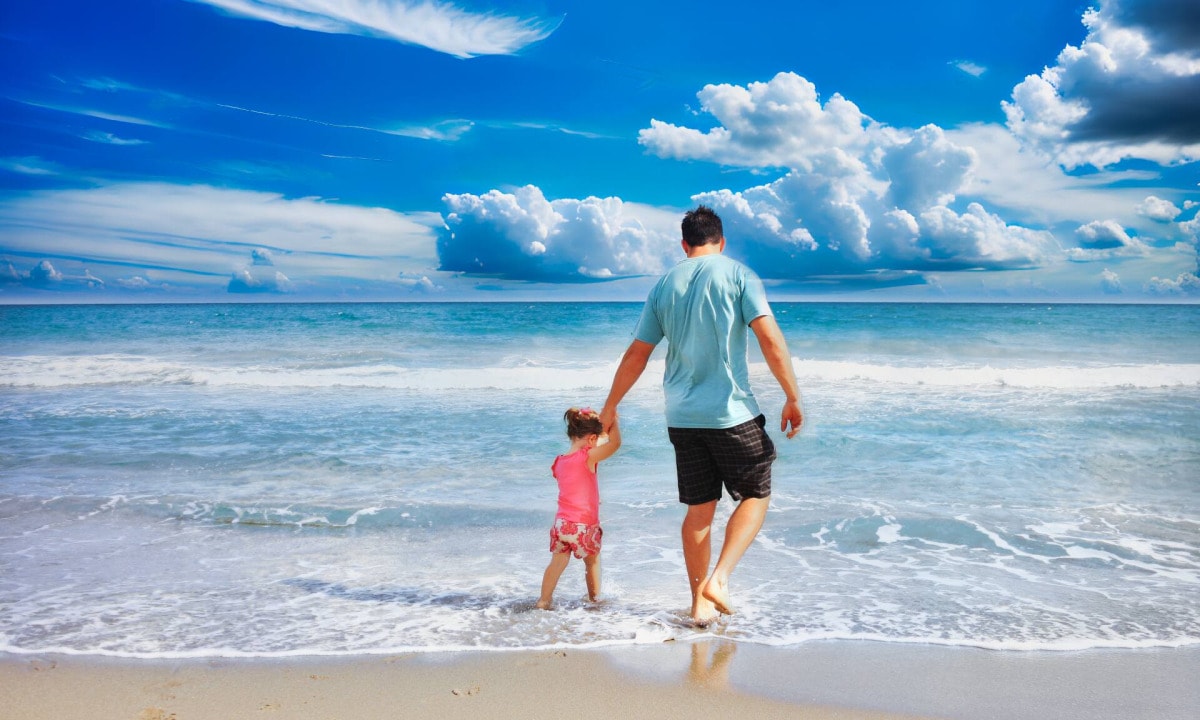 If you are planning a family vacation that is perfect for both kids and adults, you should consider the picturesque North Sea region in Germany. With its cheerful and lively atmosphere, the German North Sea coast offers great weather, breathtaking scenery and plenty to see and do.
One of the most popular destinations is the island of Sylt. Known for its beautiful beaches and iconic architecture, Sylt offers a variety of attractions and activities. You can take the whole family for a walk on the white sandy beaches or explore the island's many hiking and biking trails.
Another worthwhile destination on the North Sea is the city of Hamburg. As the second largest city in Germany, Hamburg is a center for culture and entertainment. Visit the Miniaturwunderland, the largest model railroad in Europe, or take a tour of the city's famous harbor.
For a more traditional family vacation, the charming coastal resorts are recommended. Here you'll find excellent seafood restaurants, unique stores and historic sights. Explore the picturesque streets of St. Peter-Ording or the quaint town of Husum.
The North Sea region also has something to offer outdoor enthusiasts. Take a whale watching tour, go surfing or kite surfing or rent a boat to explore the many canals and waterways.
Whatever your interests, the German North Sea is the perfect destination for a family vacation. With its lively atmosphere, breathtaking scenery and many activities, there's something for everyone. So pack your bags, pack your sunscreen and let's go.
If you are planning a family vacation that is perfect for both kids and adults, you should consider the picturesque North Sea region in Germany. With its cheerful and lively atmosphere, the German North Sea coast offers great weather, breathtaking scenery and plenty to see and do.
One of the most popular destinations is the island of Sylt. Known for its beautiful beaches and iconic architecture, Sylt offers a variety of attractions and activities. You can take the whole family for a walk on the white sandy beaches or explore the island's many hiking and biking trails.
Another worthwhile destination on the North Sea is the city of Hamburg. As the second largest city in Germany, Hamburg is a center for culture and entertainment. Visit the Miniaturwunderland, the largest model railroad in Europe, or take a tour of the city's famous harbor.
For a more traditional family vacation, the charming coastal resorts are recommended. Here you'll find excellent seafood restaurants, unique stores and historic sights. Explore the picturesque streets of St. Peter-Ording or the quaint town of Husum.
The North Sea region also has something to offer outdoor enthusiasts. Take a whale watching tour, go surfing or kite surfing or rent a boat to explore the many canals and waterways.
Whatever your interests, the German North Sea is the perfect destination for a family vacation. With its lively atmosphere, breathtaking scenery and many activities, there's something for everyone. So pack your bags, pack your sunscreen and let's go.
 Are you looking for a short vacation that will relax, refresh and rejuvenate you? Then a spa break at the North Sea is just what you need. Here you can enjoy all the beauty, tranquility and pampering that this stunning region has to offer.
When you book a spa getaway to the North Sea, you'll be pampered from the moment you arrive. Most spas in the region offer a range of pampering treatments and services, including rejuvenating facials, soothing massages, detoxifying body wraps, and more.
But that's just the beginning. A spa vacation also means taking time to relax, slow down and immerse yourself in the tranquility of your surroundings. A North Sea spa offers tranquil coastal views, refreshing sea breezes, and plenty of opportunities for outdoor activities like biking, hiking, and walking along miles of secluded beaches.
And the best part? After a day of pampering and activities, you can retreat to your cozy and comfortable accommodations, which are generally all about relaxation. The bright and airy rooms invite you to unwind and leave your everyday life behind. Many North Sea resorts also have restaurants where you can enjoy healthy and delicious dishes made from fresh, regional ingredients.
So why wait? Book your short break with wellness at the North Sea today and get ready for a truly relaxing vacation that will leave you refreshed, revitalized and ready for everything life has to offer. There is so much to see, do and discover in this beautiful region that you will have an unforgettable time from start to finish.
Are you looking for a short vacation that will relax, refresh and rejuvenate you? Then a spa break at the North Sea is just what you need. Here you can enjoy all the beauty, tranquility and pampering that this stunning region has to offer.
When you book a spa getaway to the North Sea, you'll be pampered from the moment you arrive. Most spas in the region offer a range of pampering treatments and services, including rejuvenating facials, soothing massages, detoxifying body wraps, and more.
But that's just the beginning. A spa vacation also means taking time to relax, slow down and immerse yourself in the tranquility of your surroundings. A North Sea spa offers tranquil coastal views, refreshing sea breezes, and plenty of opportunities for outdoor activities like biking, hiking, and walking along miles of secluded beaches.
And the best part? After a day of pampering and activities, you can retreat to your cozy and comfortable accommodations, which are generally all about relaxation. The bright and airy rooms invite you to unwind and leave your everyday life behind. Many North Sea resorts also have restaurants where you can enjoy healthy and delicious dishes made from fresh, regional ingredients.
So why wait? Book your short break with wellness at the North Sea today and get ready for a truly relaxing vacation that will leave you refreshed, revitalized and ready for everything life has to offer. There is so much to see, do and discover in this beautiful region that you will have an unforgettable time from start to finish.
 If you're traveling through Europe and looking for cheap, comfortable accommodation on the North Sea, a youth hostel is a great choice. Youth hostels offer a safe and friendly environment where travelers can meet new people, explore new places and have fun. North Sea hostels are particularly popular, with their excellent location and wide range of leisure activities.
When you arrive at a hostel, you'll be greeted by friendly staff who love travel and hospitality. They will show you to your room, which can be a single or shared, and inform you about the facilities available to guests. Youth hostels are known for their clean and comfortable accommodations, where every guest will find fresh linens and towels.
The best part about staying in a hostel is the lively and fun atmosphere. There are common areas such as lounges, kitchens and dining rooms where you can meet other guests, cook together and share travel stories. Some hostels have outdoor areas such as courtyards, gardens or terraces where you can enjoy the beautiful scenery and fresh sea air.
North Sea hostels are often located near popular attractions, landmarks and natural beauty spots. This makes it easy to explore the surrounding area and return to the hostel.
If you're traveling through Europe and looking for cheap, comfortable accommodation on the North Sea, a youth hostel is a great choice. Youth hostels offer a safe and friendly environment where travelers can meet new people, explore new places and have fun. North Sea hostels are particularly popular, with their excellent location and wide range of leisure activities.
When you arrive at a hostel, you'll be greeted by friendly staff who love travel and hospitality. They will show you to your room, which can be a single or shared, and inform you about the facilities available to guests. Youth hostels are known for their clean and comfortable accommodations, where every guest will find fresh linens and towels.
The best part about staying in a hostel is the lively and fun atmosphere. There are common areas such as lounges, kitchens and dining rooms where you can meet other guests, cook together and share travel stories. Some hostels have outdoor areas such as courtyards, gardens or terraces where you can enjoy the beautiful scenery and fresh sea air.
North Sea hostels are often located near popular attractions, landmarks and natural beauty spots. This makes it easy to explore the surrounding area and return to the hostel.
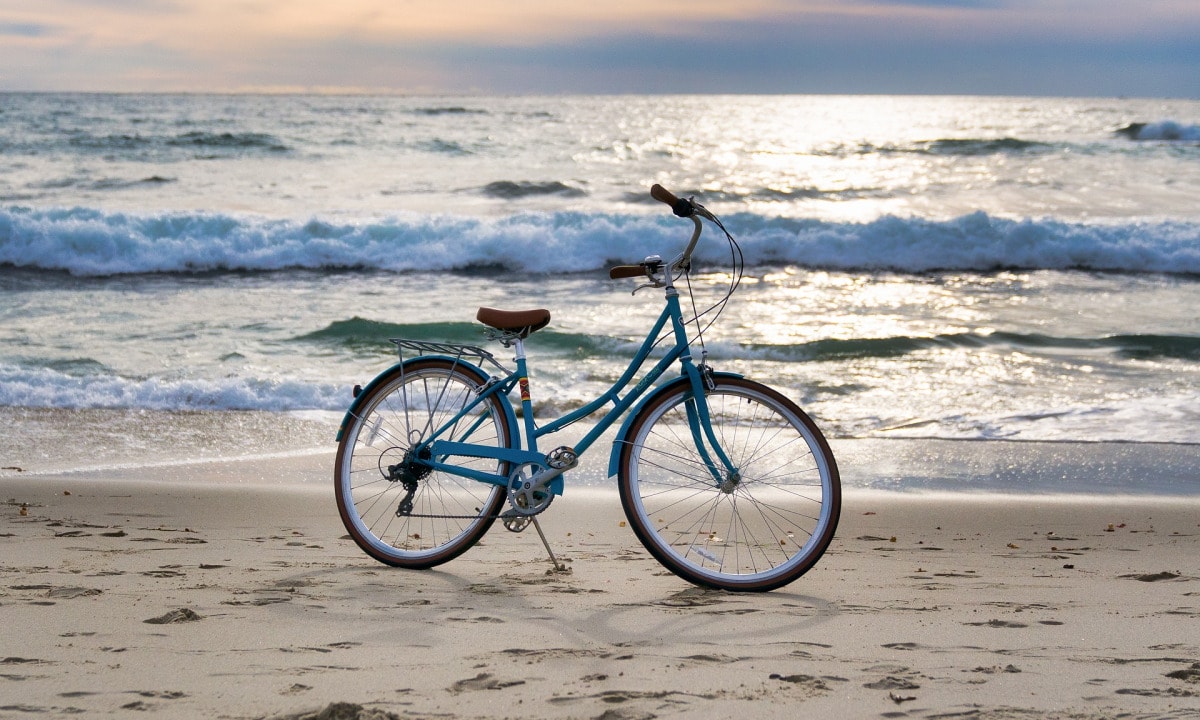 An active vacation with lots of activities like hiking, biking, canoeing and surfing will never be boring. Plus, an active vacation can help you stay fit and healthy. You can explore nature and get physical exercise at the same time, which can improve your overall well-being.
However, an active vacation can also have its disadvantages. For one, it can be exhausting, especially if you're not used to being so active. You have to be willing to exert yourself physically and mentally to get the most out of your vacation.
It can also be more expensive than a normal beach vacation. You'll have to buy equipment or pay for guided tours, which can add up quickly.
Despite these potential drawbacks, a North Sea vacation can be incredibly fulfilling. Not only will you get to experience nature and stay healthy, but you'll also meet new people and make lasting memories.
You may also have the opportunity to try new sports. Surfing, for example, is a popular pastime at the North Sea - and even if you're a beginner, there are plenty of surf schools that will teach you the basics.
An active vacation with lots of activities like hiking, biking, canoeing and surfing will never be boring. Plus, an active vacation can help you stay fit and healthy. You can explore nature and get physical exercise at the same time, which can improve your overall well-being.
However, an active vacation can also have its disadvantages. For one, it can be exhausting, especially if you're not used to being so active. You have to be willing to exert yourself physically and mentally to get the most out of your vacation.
It can also be more expensive than a normal beach vacation. You'll have to buy equipment or pay for guided tours, which can add up quickly.
Despite these potential drawbacks, a North Sea vacation can be incredibly fulfilling. Not only will you get to experience nature and stay healthy, but you'll also meet new people and make lasting memories.
You may also have the opportunity to try new sports. Surfing, for example, is a popular pastime at the North Sea - and even if you're a beginner, there are plenty of surf schools that will teach you the basics.


